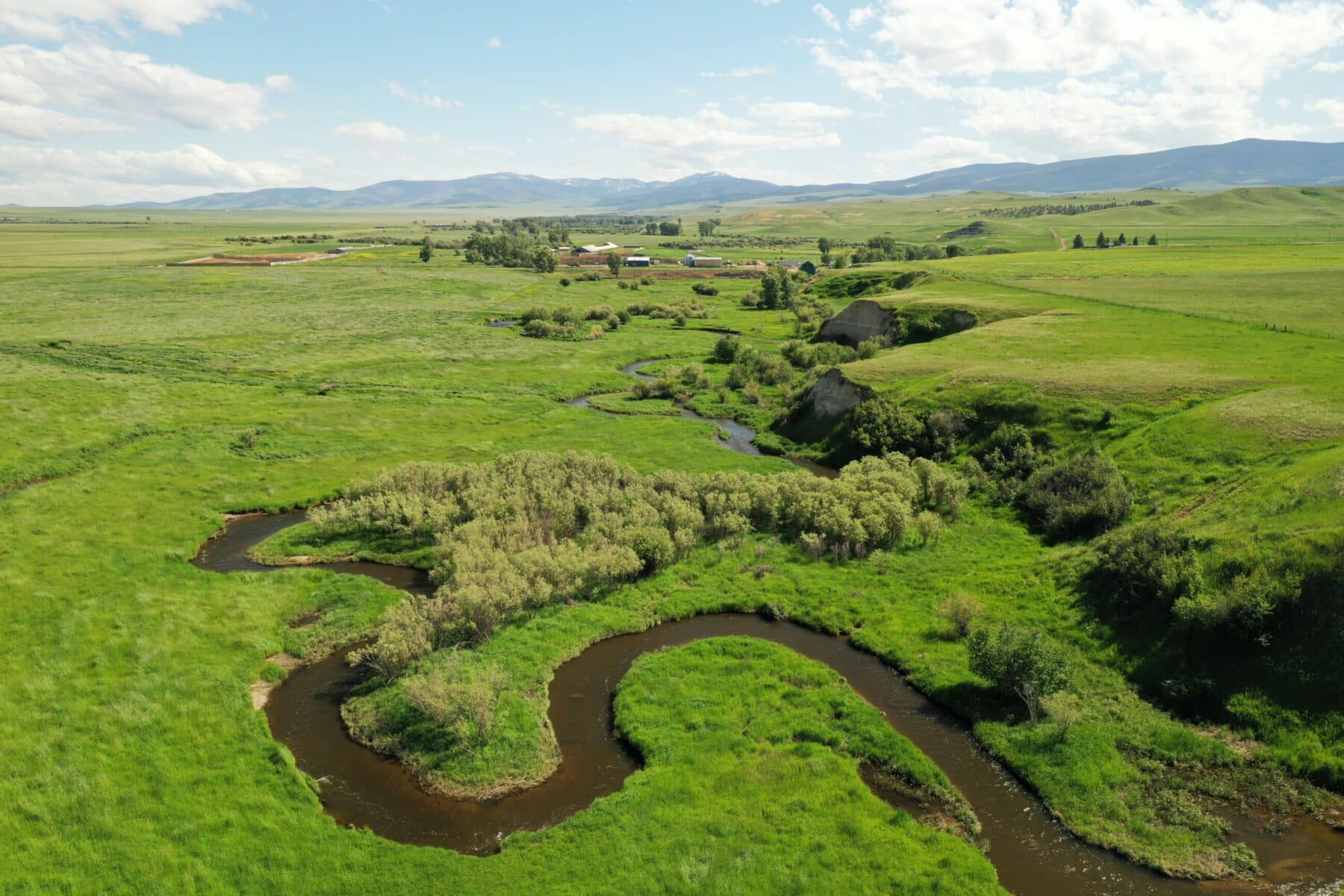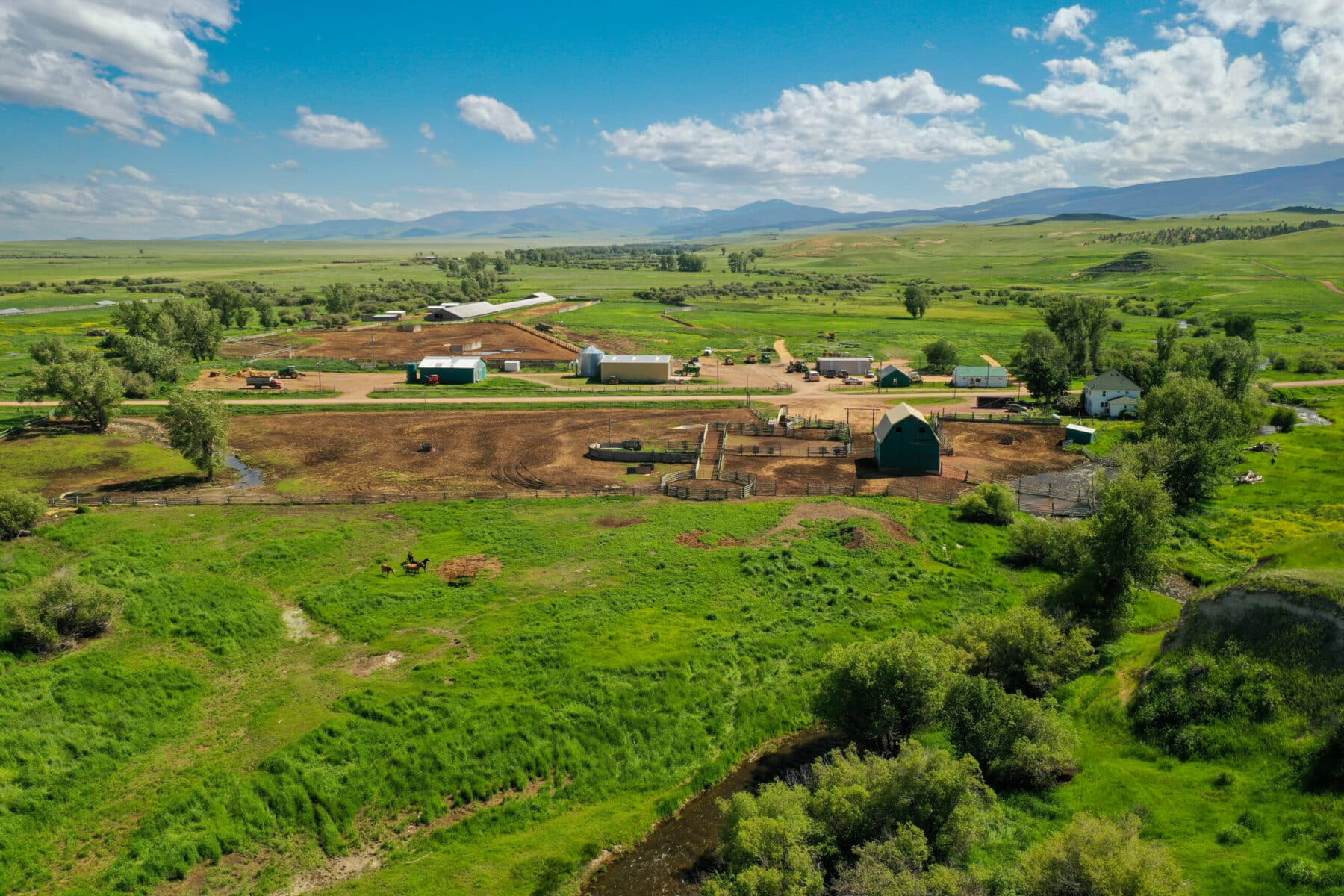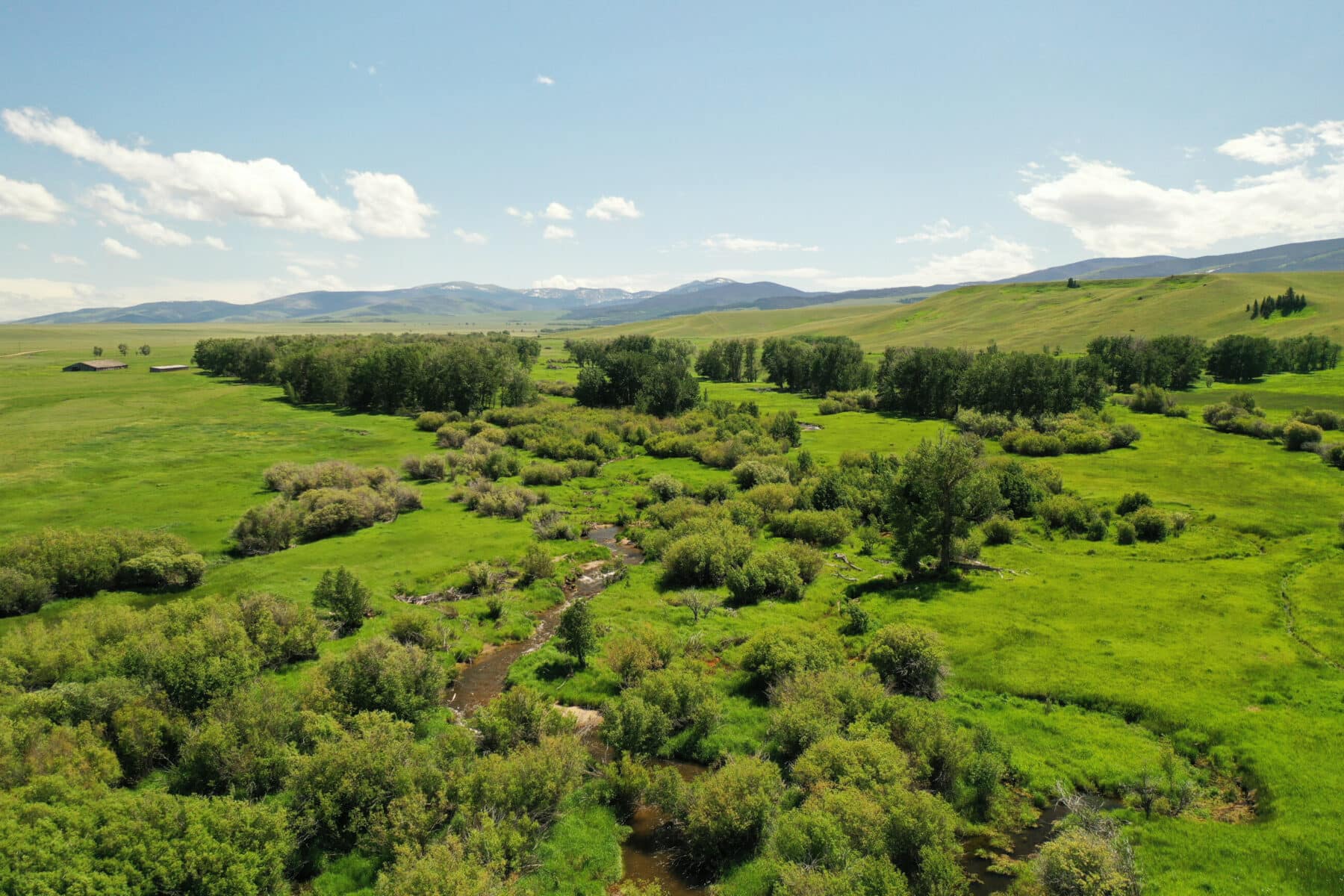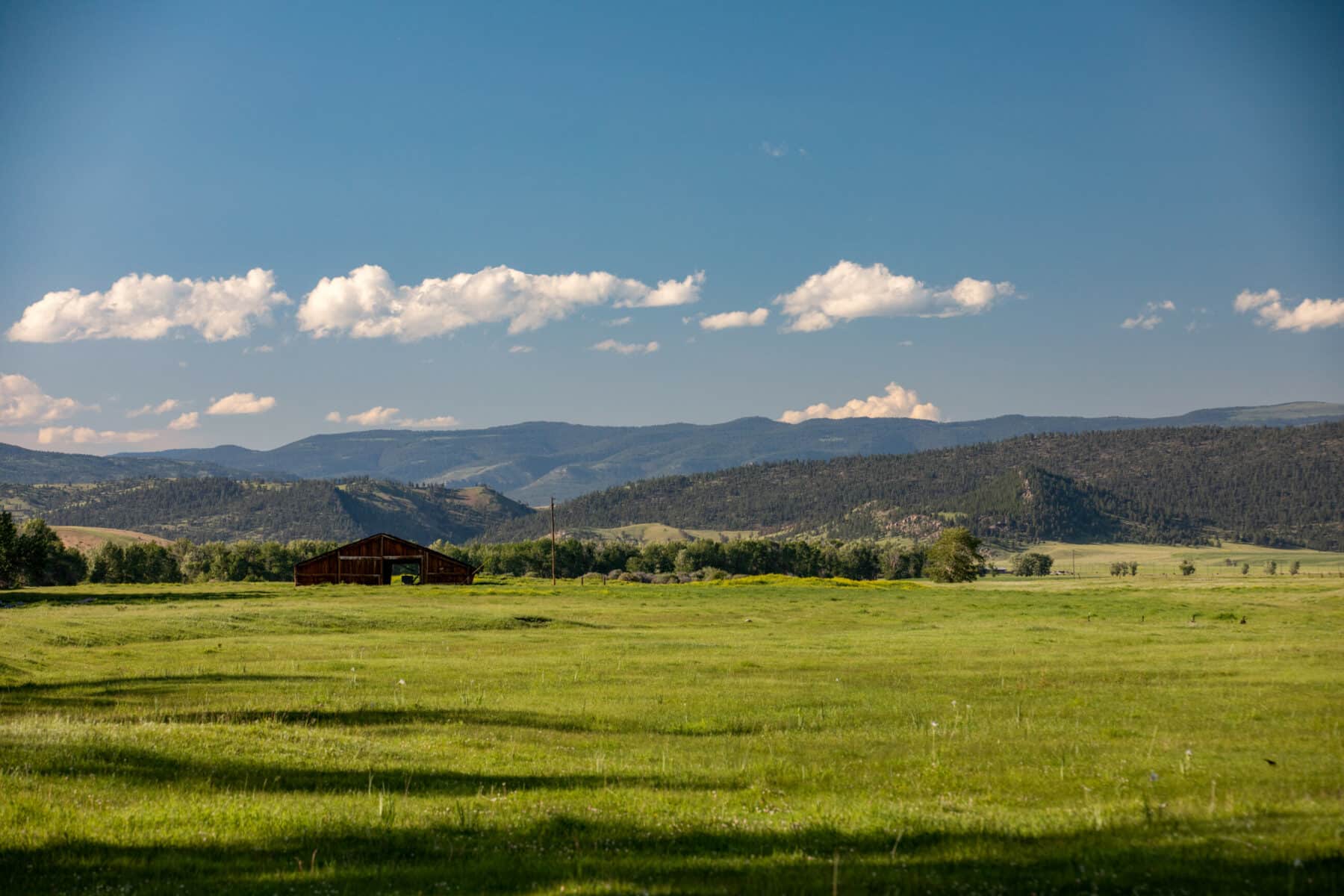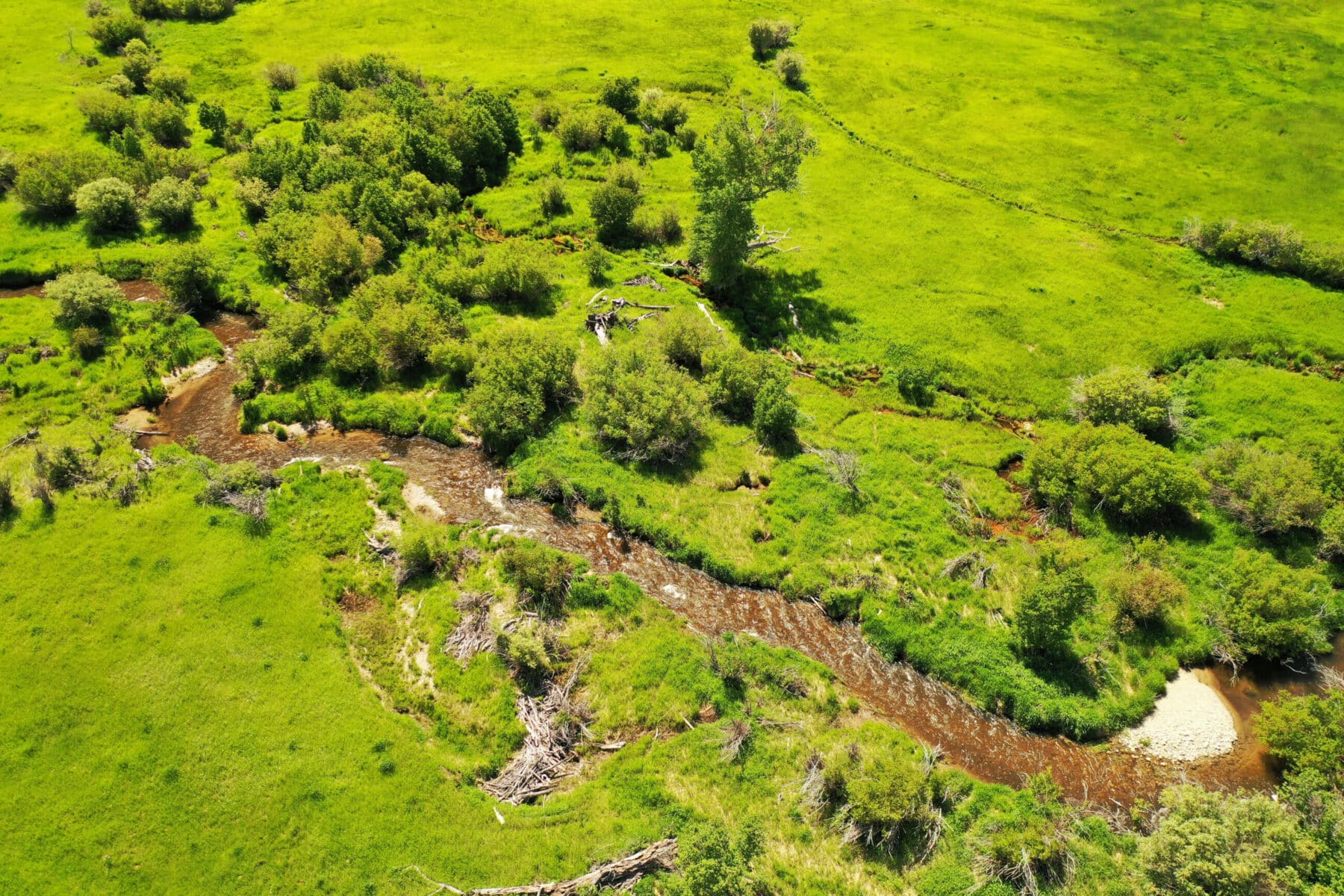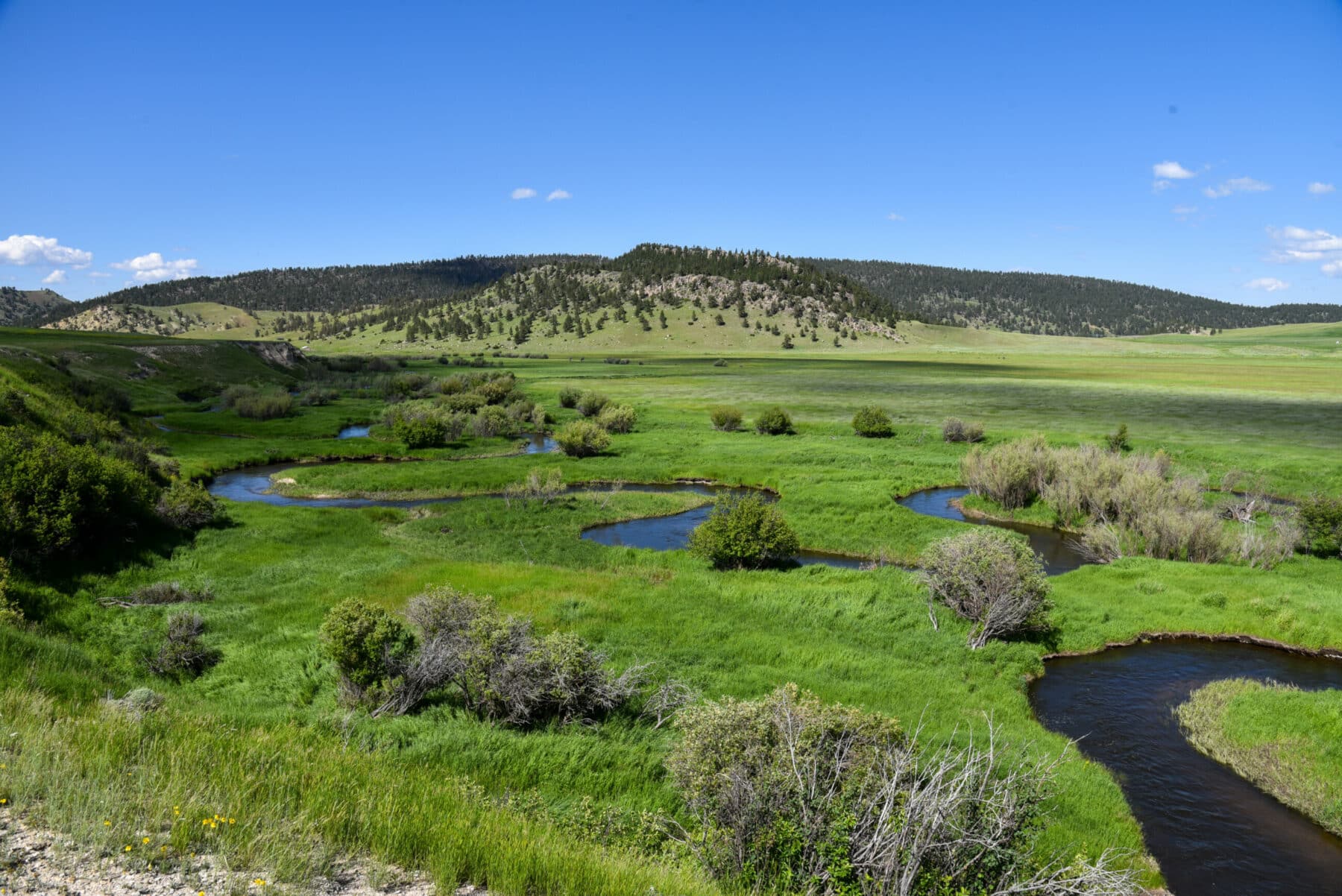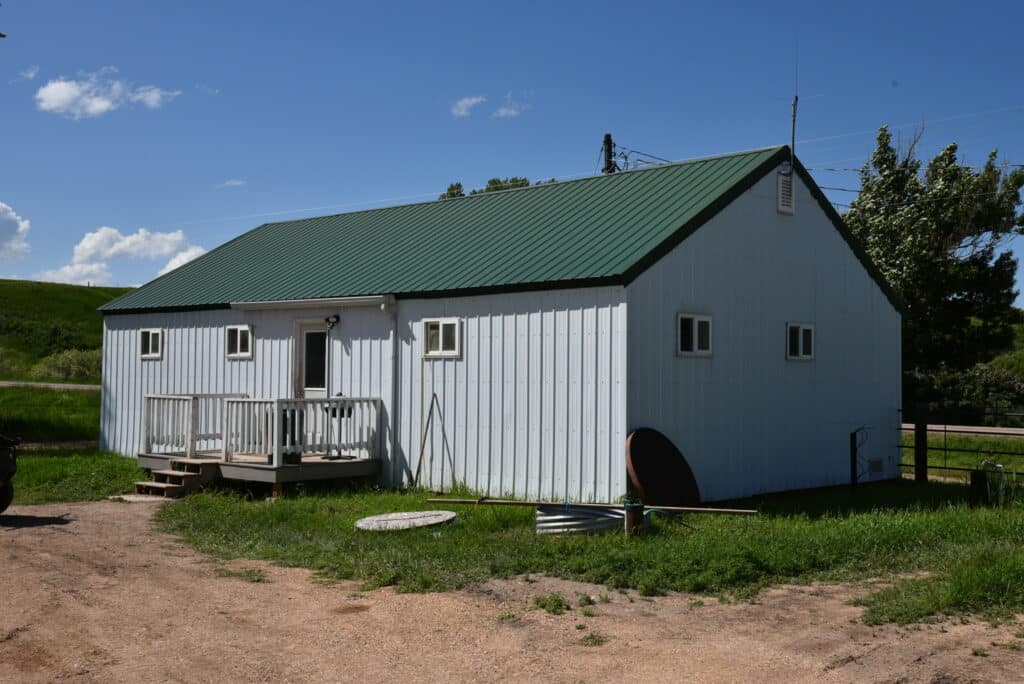Historic Montana Ranch for sale 1st time in a century
Meagher County
Camas Creek Cattle & Sheep Company
Camas Creek Cattle & Sheep Company is a historical ranching operation that has not been offered to the market in over 100 years—a true legacy of the Doggett Family’s hard work, grit, commitment, and love for the land.
Consisting of about 36,621± total acres and capable of running approximately 1,800 animal units—these large-legacy production ranches are a rarity in today’s market.
It is located in a stunning central Montana setting at the headwaters of the famed Smith River between the Big Belt and Little Belt Mountain ranges.
The Doggett Family history in Montana dates to the 1860s when Virginia City was the territorial capital and the home to many ambitious pioneers exploring the area for gold. The Doggett Family transitioned from mining around Virginia City to ranching in central Montana in the late 1800s and have been diligently running sheep, cattle, and growing crops for nearly 160 years.
Camas Creek Cattle & Sheep Company possesses the highly coveted and surprisingly rare combination of tremendous recreational amenities with exceptional live-water resources and a productive balanced agricultural operation—all within a short drive to all the community services in White Sulphur Springs. Showdown Ski Area is about 30 minutes from White Sulphur Springs, and the larger cities of Bozeman, Helena, and Livingston are all within about two hours.
Camas Creek Cattle & Sheep Company represents the pinnacle of Montana ranch ownership due to the exemplary stewardship of the Doggett Family. The stage has been set for a seamless transition of the ranch to start the next phase of the Camas Creek Cattle & Sheep Company legacy.
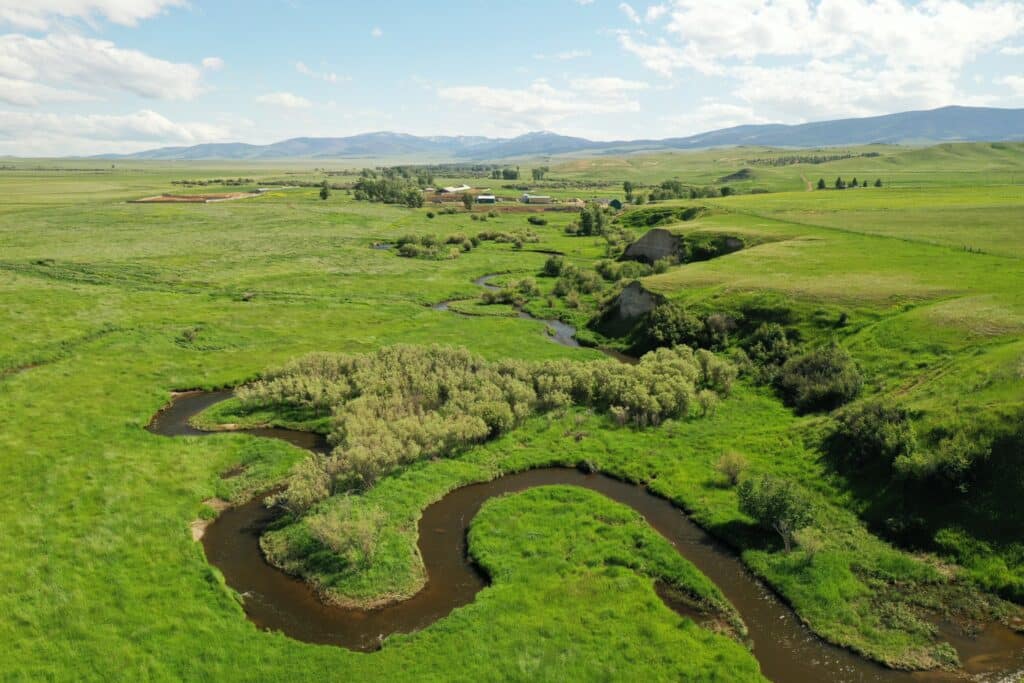
Camas Creek Cattle & Sheep Company is located about 18 miles from downtown White Sulphur Springs in Meagher County via the paved Highway 360, which is also known as Fort Logan Road, to the ranch headquarters along Camas Creek.
White Sulphur Springs is a lively small Montana town that features the “Red Ants Pants Music Festival”—one of the largest summer music festivals in the state. White Sulphur Springs offers all the necessary amenities such as restaurants, groceries, banking, health care, ranch supplies, and fuel for residents and travelers. In addition, area recreational opportunities are abundant in summer and winter. The larger communities of Livingston, Helena, and Bozeman are all under two hours away with expanded business offerings and services.
The ranch is easily accessed year-round via several main highway routes and less than 2.5 hours from three commercial airports in Helena, Bozeman, and Billings. There is also a small private airfield in White Sulphur Springs (FAA 7S6) with a 6,100’ paved runway, A-1 jet fuel, and other FBO services.
Recently upgraded, Bozeman Yellowstone International Airport at Gallatin Field in Belgrade (BZN) offers several full-service FBOs, including the Yellowstone Jet Center, and excellent commercial services through Alaska, Allegiant, American, Delta, Frontier, Southwest, JetBlue, Sun Country, and United Airlines. One of the busiest passenger airports in the Pacific Northwest, and the busiest in the state of Montana, BZN offers direct flights to 25 major airports around the nation including direct flights to the West Coast, East Coast, Texas, the Southeast, and Florida.
Approximate distances to other cities and attractions are as follows:
| White Sulphur Springs, MT Camp Baker on the Smith River Showdown Ski Area Bridger Bowl Ski Area Livingston, MT Helena, MT Bozeman, MT Bozeman-Yellowstone International Airport Yellowstone National Park – North Entrance (Gardiner) |
18 miles |
 |
 |
The ranch is physically in three distinct units that were historically used to run several bands of sheep and since the 1950s as a cow/calf ranch operation. The Headquarters Unit is the home base for the year-round operation and provides the irrigated hay ground for the winter feed base along Camas Creek. The Headquarters Unit is nicely complemented by two mountain pasture units, Democrat Unit and Clear Range Unit, which are used for seasonal grazing and big game hunting, and offer panoramic vistas of the surrounding country.
Camas Creek Cattle & Sheep Company sits in a classic central Montana setting, featuring an open valley rimmed with distant mountain peaks and Camas Creek flowing through the heart of the Headquarters Unit for over 7.5 miles. The live water of Camas Creek creates a very special small stream fishery and a stunning tree-filled riparian corridor with multiple private meadows filled with wildlife in every season. This is the creek bottom that every ranch buyer envisions having on their Montana ranch, but so few ranches can deliver.
Camas Creek Cattle & Sheep Co. encompasses approximately 36,621± total acres comprised of the following:
| 29,158± 3,625± 3,200± 638± |
Deeded Acres State of Montana Lease Acres United States Forest Service Lease Acres Bureau of Land Management (BLM) Lease Acres |
The deeded land is generally classified as follows:
| 25,922± 2,036± 1,200± |
Acres of Native Range, Improved Pasture, and Timber Acres of Irrigated Acres of Riparian Corridor along Camas Creek |
The leased land is generally classified as follows:
United States Forest Service Permit No. 10080P
385 AUs from mid-June to mid-September
BLM Lease Allotment No. MT06294
638± Acres (50 AUMs)
State of Montana DNRC Leased Land
3,625± Acres of State of Montana Lease
The Camas Creek riparian corridor encompasses nearly 1,200 acres of native grass. This lush riparian corridor is lined with healthy stands of cottonwoods and willows, providing protective cover for the mother cows having their calves in the winter as well as a habitat for the abundant populations of wildlife throughout the year. The Headquarters Unit on Camas Creek was purchased in 1981 from the Manger Family and is commonly referred to today as the “Manger Place.” Jock Doggett’s father, Jeff Doggett, purchased the ranch for its abundant water resources, cover, and productive native grasses.
“The water rights alone, will capture the money we will have to pay for this place,” Jeff stated to his son.
The seller believes the ranch can conservatively run 1,200 mother cows with about 600 head of yearlings plus bulls and replacement heifers. During a normal winter, the ranch will feed about two tons of hay per cow.
Bulls are put out with heifers on the first of June and then with the cows around the middle of June. This puts the heifers calving in mid-March and cows beginning in late March/early April. Calves will wean off the younger cows around the 25th of September. The calves will be weaned off the older cows in two groups in early October. After weaning, steer calves are put on the pivot pastures until they are shipped in January at about 650 pounds. Heifer calves are backgrounded in one of three feedlot facilities and sorted with the top end being kept for replacement heifers and the balance shipped in March.
The 8,777± total acres of the Headquarters Unit of which 8,617± are deeded is positioned along Fort Logan and Camas Creek Roads.
This unit is generally allocated as follows:
| Irrigated Crop Land Dry Land Pasture Riparian State of Montana Improvements |
2,025± |
The Headquarters Unit is the central hub of the ranch where the main working improvements are located and includes an employee house, ranch office, working shop, several equipment storage sheds, calving barns, the main corral system, and livestock scale.
One of the owner’s homes is situated about three miles south of the Headquarters Unit via Camas Creek Road. Another owner home, which is lovingly referred to as “Mom’s House”, is located on a bluff above the ranch headquarters overlooking Camas Creek.
 |
 |
Located about 3.5 miles south of the Headquarters Unit improvements and along Camas Creek Road, a good set of working improvements, known as “The Tub”, includes corrals and a calving shed with lights. With power pulled into the facility, this set of corrals has worked well for weaning.
The pivot irrigated alfalfa fields located at the Headquarters Unit are predominately planted in Round-Up Ready alfalfa and have historically brought yields between 4.5 to 5 tons per acre. The non-irrigated pasture ground is comprised of healthy stands of high-protein native grasses.
Doggett Reservoir teems with both native rainbow trout as well as stocked Kamloops. Doggett Reservoir is completely private, and the water is solely utilized by the ranch—a tremendous irrigation and recreational resource. The dam is inspected by the state annually and maintained by the ranch in accordance with State of Montana guidelines.
Doggett Reservoir, which is about 30 acres in size, is fed by Harris Creek, Moose Creek, Elk Creek, and Mule Creek and supplies about 720± acres of pivot and wheel-line-irrigated acres, and about 60± acres of flood-irrigated cropland to the north of the reservoir. The approximately 1,316± irrigated crop acres remaining on the southern portion of the ranch are irrigated with Camas Creek water.
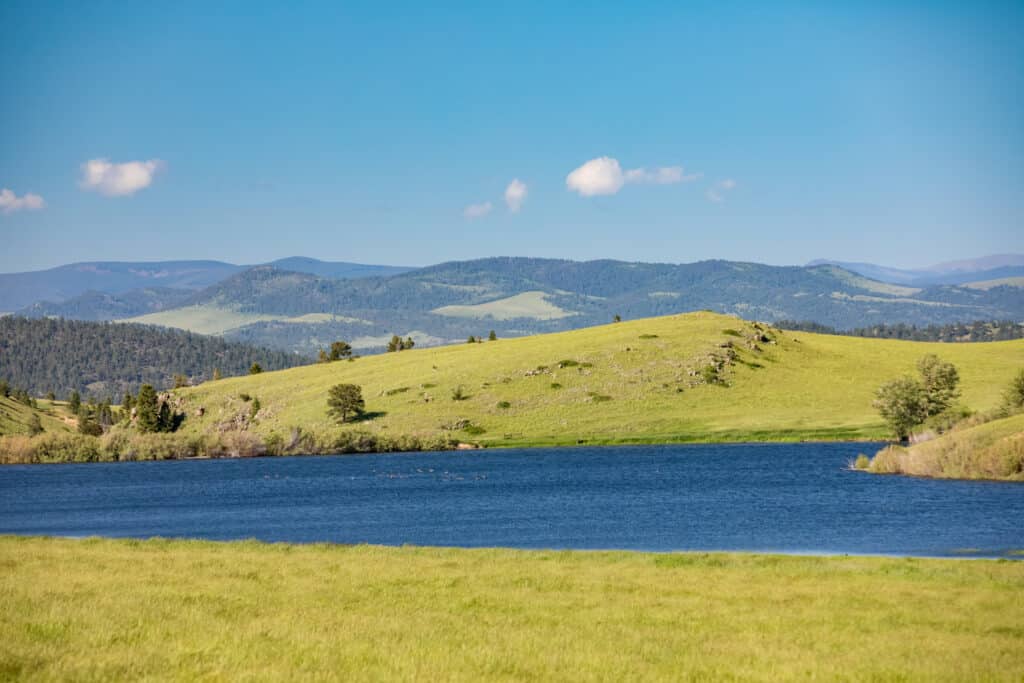
Ayers Reservoir, another ranch-owned private water-storage reservoir, retains irrigation water much of the spring and summer for late-season irrigation at which time the water is released into the Camas Ditch to irrigate the second cutting hay crop. There are no fish in Ayers Reservoir, however, it does attract large numbers of waterfowl during their migration south.
With about 4,189± deeded acres, this unit was logged about 30 years ago to manage the resource and open more of the native grass. This process left behind an extensive road network that traverses this rugged mountain unit. The countryside is well healed from the logging operation, but there was a forest fire in the neighboring national forest land in 2021 that burned approximately 200 acres of the southern tip of the Democrat Unit. The noxious weeds have been actively managed to support the grass resource and maximize production.

The acreage breakdown of the Democrat Unit is generally as follows:
| Scattered Timber Pasture Dry Land Pasture |
2,795± |
The landscape of the Democrat Unit is diverse with steep hillsides, timbered ridges, and the lush valley floor. It has historically been a productive summer grazing unit while providing abundant opportunities to hunt elk, grouse, and mule deer.
Several small spring-fed mountain streams traverse this unit combined with several stock tanks in strategic locations providing consistent water sources for livestock and wildlife. Surrounded by US National Forest on three sides, the nearest public access to the national forest is nearly five miles away over treacherous terrain. While not contiguous with the Headquarters Unit, there is a recorded easement that secures access and provides the opportunity for the next owner to pull power and improve the road into this unit should they desire.
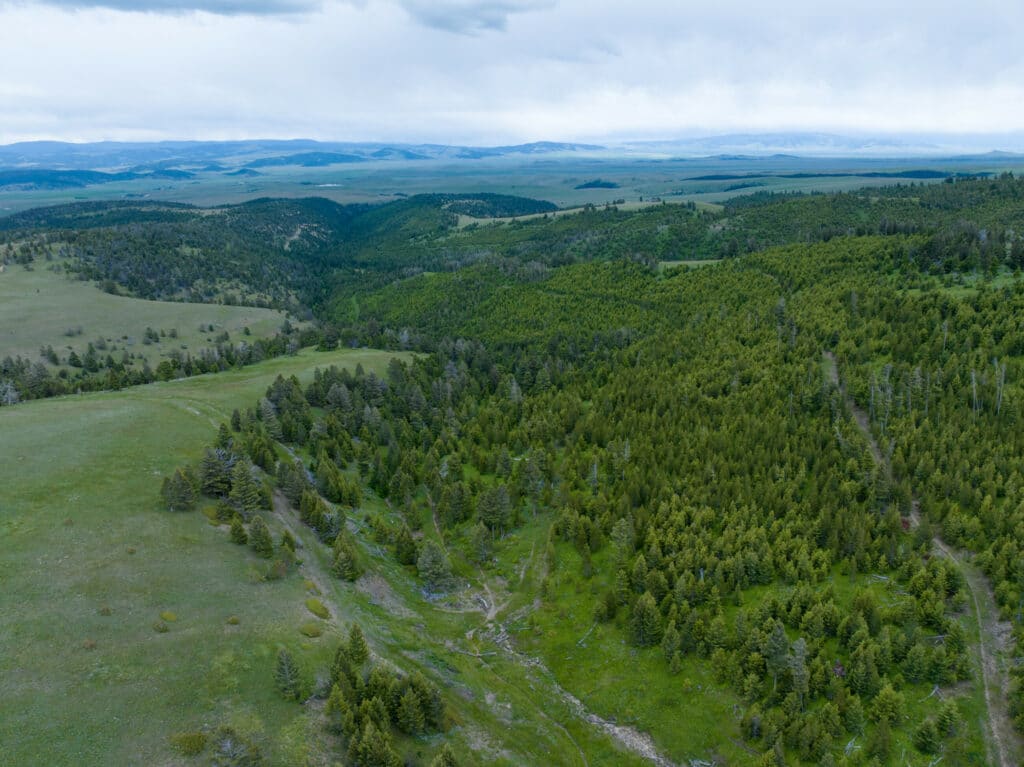 |
 |
The 23,655± total acres of which 16,352± are deeded of the Clear Range Unit are located in the foothills between the Big Belt and Little Belt Mountain ranges, with Beaver Creek running from west to east through the ranch before joining the Smith River about a half mile east of the Clear Range Unit.
This is an extremely private setting with no public access and only a couple of large historic ranches as neighbors. This productive unit provides summer pasture and excellent big-game hunting. There is a good gravel road that provides all-season access to the southeast corner of the Clear Ranch Unit and Hwy 360, also known as ‘Lingshire Road’, that continues to Great Falls and crosses the very western portion.
There is a great network of internal roads that provides driving access to the entire Clear Range Unit. With well-maintained gravel county roads on both flanks, a nice road loop traverses the Clear Range Unit without backtracking.
The acreage breakdown of the Clear Range Unit is generally as follows:
| Total Deeded Acres Dry Land Pasture Improved Pasture Scattered Timber Pasture |
16,352± |
| Total Leased Acres State of Montana Lease BLM Lease USFS Lease |
7,303± |
The improved dryland pastures on the ranch are predominantly planted into crested wheat grass. Cattle are trailed from the Headquarters Unit to the “Cistern Pasture” of the Clear Range Unit in mid-June. The cow-calf pairs are rotated among the 22 pastures throughout the summer months. Typically, cattle remain on the Clear Range Unit until late November to early December before they come back to the irrigated meadows at headquarters.
A well-positioned set of corrals is located on the Clear Range Unit near Lingshire Road. A covered shed is utilized as a chute house. The corrals are in very good repair and suitable to bring in large cattle trucks. A productive well is located near this set of corrals that feeds a pipeline that traverses the higher ground and feeds a series of four stock tanks.
Beaver Creek is a year-round stream that serpentines through the Clear Range Unit. The deep cuts and willow-laden banks provide excellent habitat for the angler looking for a private small stream fishery. Beaver Creek and Dry Beaver Creek both traverse the Clear Range Unit from west to east and eventually join and then continue their flow into the Smith River just east of the unit in a section of State of Montana ground. A consistent year-round flow provides reliable livestock water as well as a haven for brook trout and an occasional rainbow and brown trout spawning from the Smith River. During the historic drought in 2021, the main creek did go underground in several sections but resurfaced and remained flowing. The flows of Dry Beaver Creek are less consistent and do not support a fishery, but it does provide reliable stock water and great wildlife habitat.
The timber on the Clear Range Unit was selectively harvested in the 1980s. The native grasses are flourishing due to careful management, extensive water development, and conservative grazing practices. The abundant strong native grass holds cattle and puts solid gain on calves and provides excellent wildlife habitat. The existing timber is in incredibly good condition.
The ranch has an arrangement with the neighbor at Rocking C Ranch to the north of the Clear Range Unit to share a livestock well that serves a pipeline filling water tanks for both the neighbor and Camas Creek Cattle & Sheep Company. There is no formal agreement in place for this shared water use, but it has historically been a mutually beneficial and amicable arrangement. Rocking C Ranch does have a road easement that traverses the eastern side of the unit and is utilized occasionally for hunting and to check cattle on their summer grazing ground. This road also provides access to a single cabin that is located about six miles north of the Clear Range Unit.
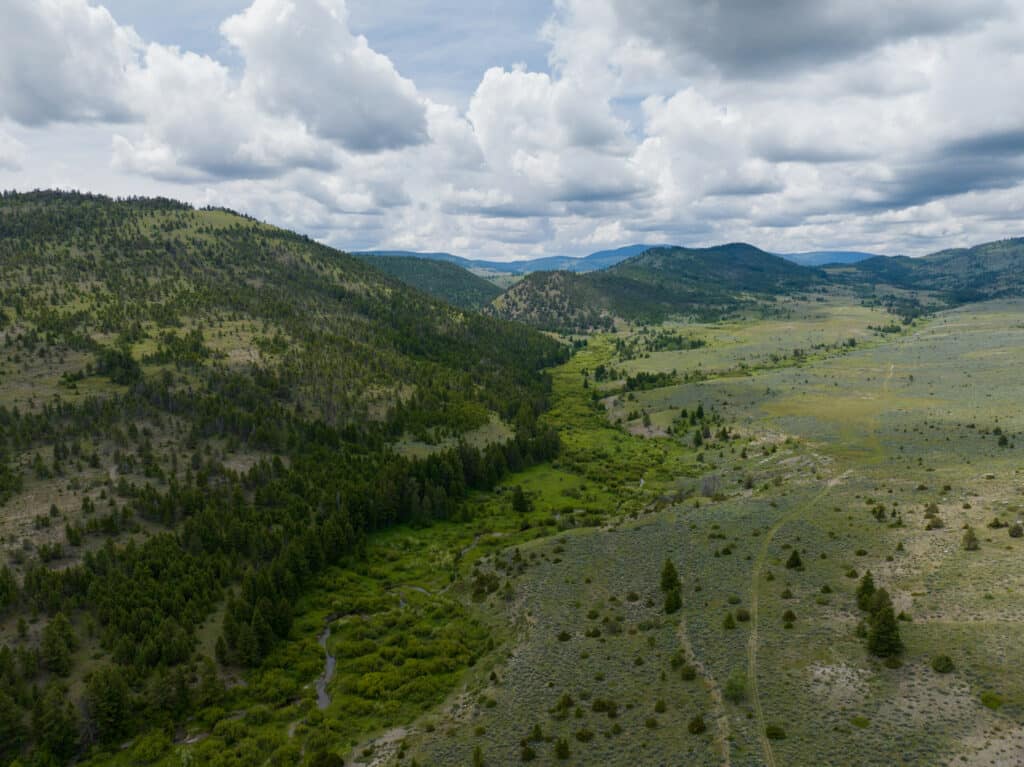
OLD GRANARY
Completed in the 1950s the Old Granary is approximately 40’ x 50’, wood frame construction with a tin roof, and has historically been used to store grain, salt, and minerals. Adjacent to the Old Granary is a 4,000-gallon liquid supplement tank with a 5-hp agitator to spray on chopped hay and grain. A 220-amp power source is located at the Old Granary to run the agitator and pump on the supplement tank. Additionally, a large, paved pad is located just south of the Old Granary where chopped hay is stored during the fall and winter-feeding seasons. Big Sky Spreading based in the Gallatin Valley is on a regular schedule to chop hay for the feedlot cattle.
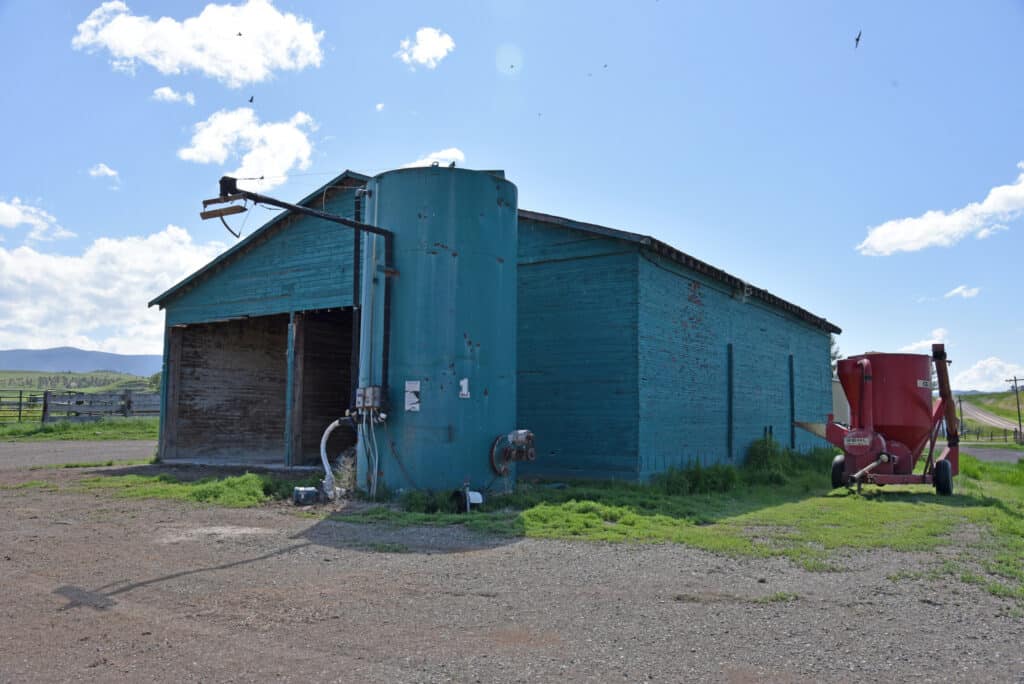 |
 |
SCALE & SCALE HOUSE
The Scale House was built in 1978. It includes a 10’ x 20’ deck and a 40,000-pound Fairbanks Morris beam scale. The scale is inspected annually by Gallatin Scale Company, typically in September. There is a set of quality corrals that surround the Scale House as well as a loading chute to accommodate the timely process of buying and selling livestock.
 |
 |
SAFECO GRAIN BIN
A 9,000-bushel bin is complete with a concrete floor, sweep, SCAFCO grain dryer system, and a 7.5 hp Hutchinson load-out auger.
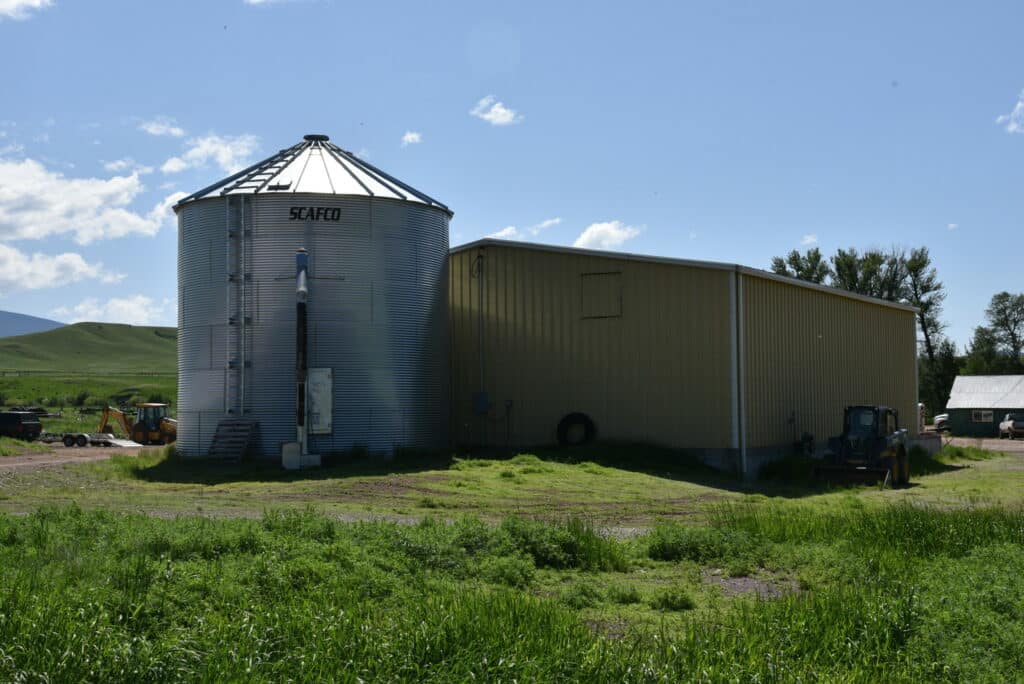 |
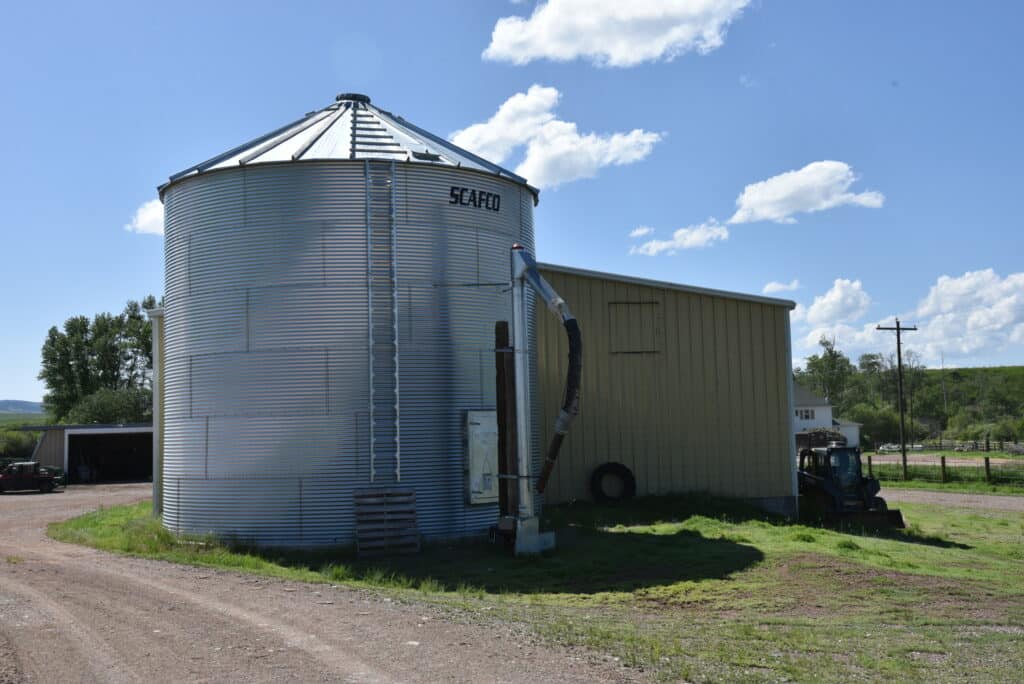 |
MAIN RANCH SHOP
Built in 1970, this 48’ x 35’ metal Quonset-style facility has gas heat, 220-amp service, and a concrete floor. It serves as the main shop on the ranch to conduct equipment repairs and maintenance.
 |
 |
METAL SHOP/STORAGE
The building is a very functional multi-purpose 45’ x 60’ metal building complete with a 22’ x 14’ roll-up door, electricity, and a full concrete floor. The building has the capacity to store about 20,000 bushels of grain on the concrete and contains in-floor augers. It is currently used to store equipment, for mechanical space, and for enclosed parking.
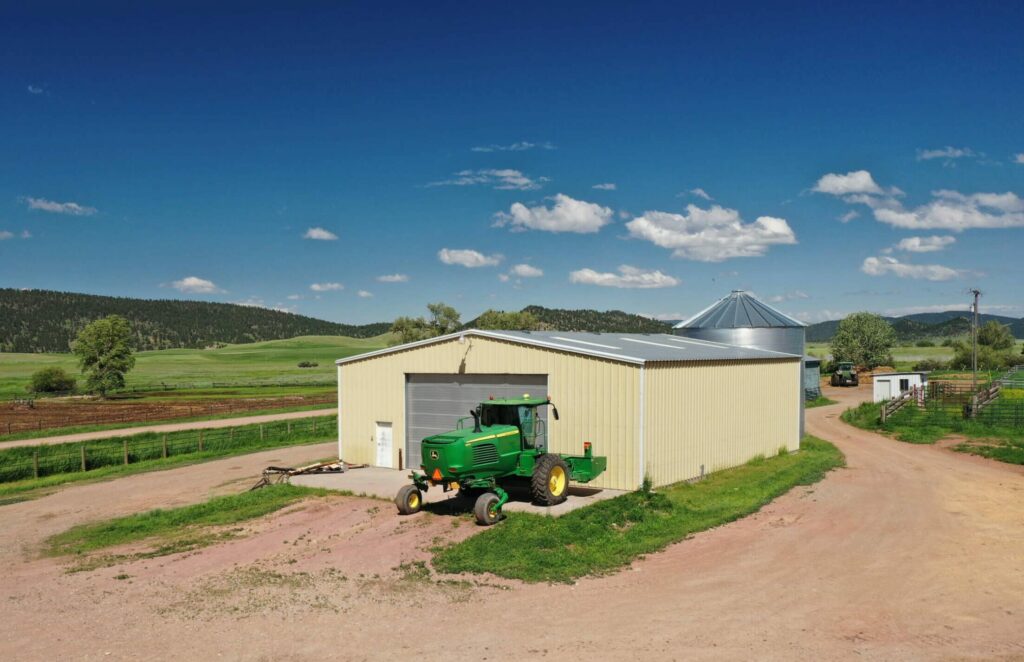 |
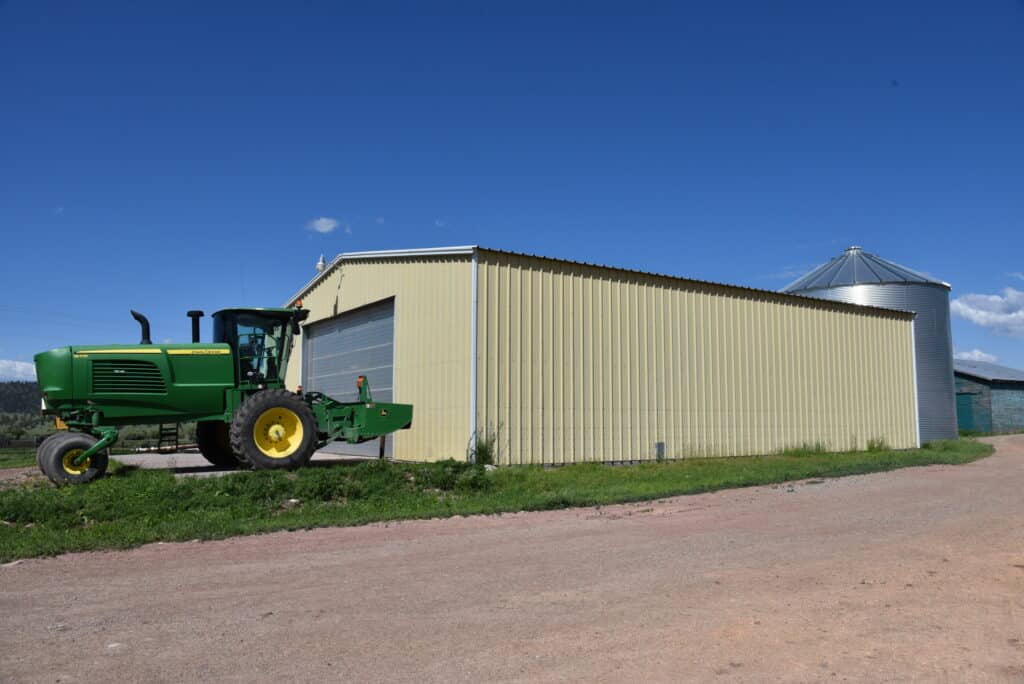 |
OLD SHOP
Constructed 120 years ago, the Old Shop contains some of the original cottonwood deck flooring. It has recently had new windows installed and sections of the floor updated. The Old Shop is currently used for storage of ranch four-wheelers. This structure also has power and a tin roof but is void of heat or insulation.
 |
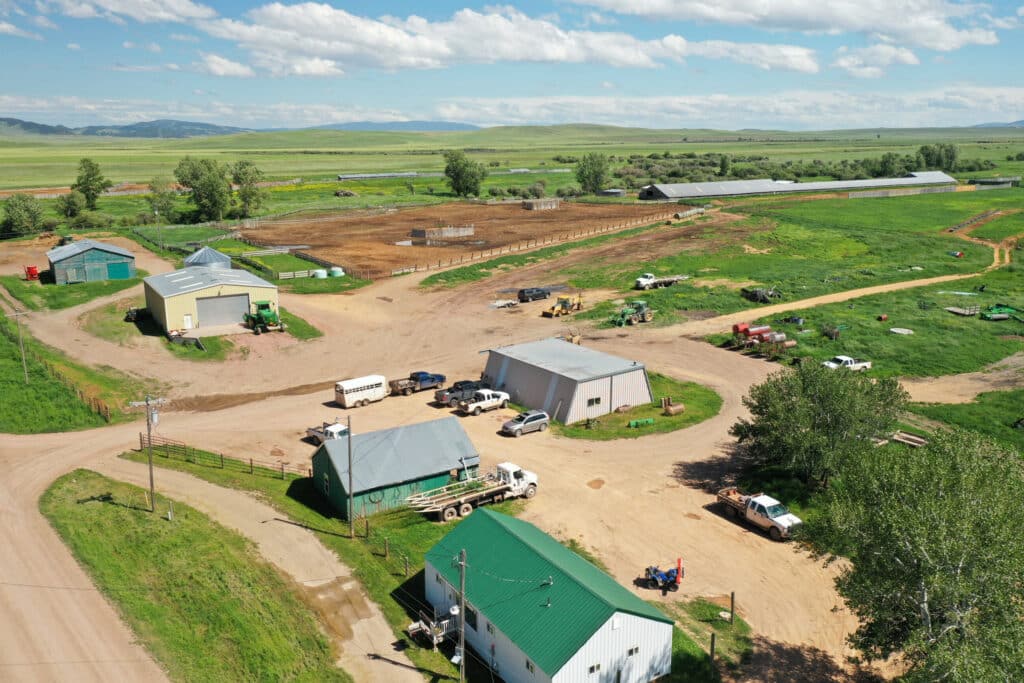 |
RANCH OFFICE AND BUNK HOUSE
This 1950s structure is about 40’ x 24’ and is referred to by the ranch hands as the ‘Think Tank and Soul Food Kitchen’. Updated with metal siding and a new metal roof, it comes complete with Wi-Fi. Serving a significant role as the main ranch office it is a place where the crew gathers regularly for a morning coffee while also performing as a general communication hub. There is a small bunkroom and bathroom, which have been used on occasion by traveling veterinarians or extra hands during calving season.
|
|
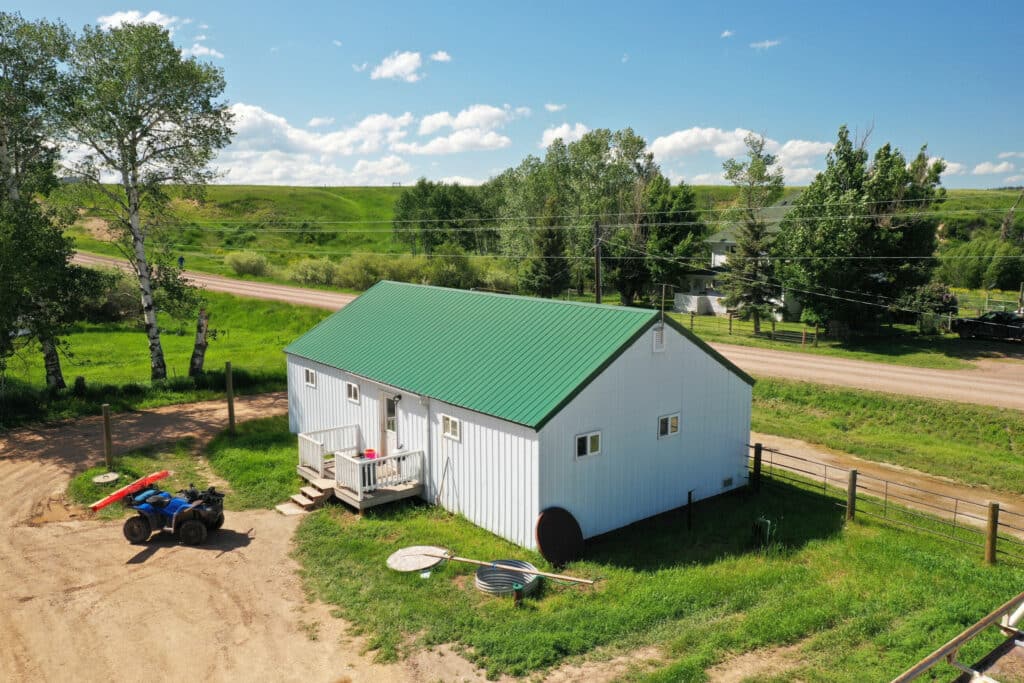 |
HISTORIC GREEN BARN AND ARENA
Raised a year after the White House in 1918, the barn is still an essential working element of the ranch and provides stalls and a tack room for the ranch horses. This building has been updated with electricity. The original cottonwood flooring has been replaced a few times over the decades but has retained the classic character of a barn that has over a century under its belt. Having been fortified through the years with a metal roof, structural cable system, and new timber frame supports, it will continue to be an iconic ranch structure for years to come. In the early years of the ranch, this area by the Green Barn was known as Fort Logan and included an old dance hall, grocery store, post office, and even a school. There is one older log building from the ‘Fort Logan’ era, near the current shop that was used as a dairy barn at one time, but now just serves as a reminder of the history of the ranch.
The corral system around the barn is well designed and can handle up to 700 calves. There is concrete under the alley that leads into the hydraulic Silencer squeeze chute, that will remain at the ranch.
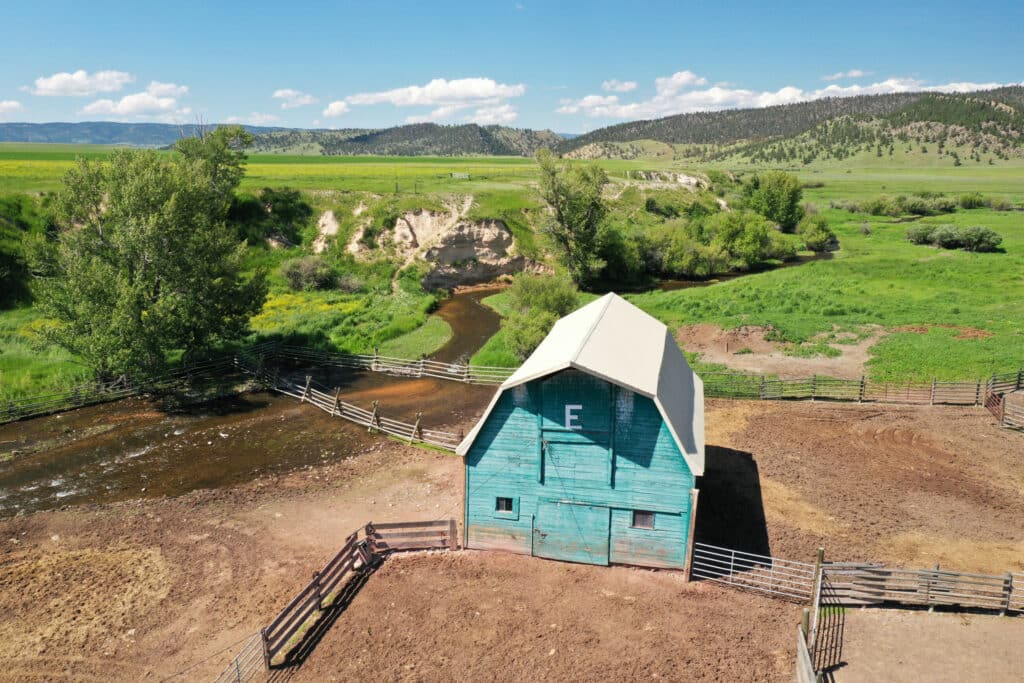 |
 |
CALVING BARNS
Added in the late 1920s, the calving barn has been updated with new wiring, a metal roof, and framing support. All of this is needed to maintain its important function, annually calving heifers. This 60’ x 180’ structure has handled calving duties for over 525 head, but on a typical year closer to 400 head. The barn, which contains 14 jugs, can be expanded with portable panels if needed. The small vet room on one end contains electric heat. The calving barn leads to a large 20’ x 200’ loafing shed that gathers the heavy heifers before their turn in the barn. The calving barn has been a host to a couple of barn owls, who have maintained a sentinel position for decades.
The loafing shed is attached to the main calving barn on the west side. On the far side of the loafing shed a second calving barn is adjacent to the loafing shed which is approximately 55’ x 75’ also with electricity and lights with a 2-W head catch. All three of these structures are wood constructed with tin roofs.
 |
 |
“MOM’S HOUSE”
Located on a beautiful bluff above Camas Creek, it became the Doggett family home after its completion in 1958. This four-bedroom, two-bathroom ranch-style home has a three-car garage and a bright appealing floor plan with lots of windows, which lends itself to the more ‘open’ concept living in many of the modern homes today. The finishes and appliances are dated; however, the structural bones have plenty of potential and the site above Elk Creek and Camas Creeks is breathtaking. The yard has a mature landscape of spruce trees with an expansive grass lawn that contains underground irrigation and is fenced. Mom’s House has both propane and electric heat with a rock fireplace in the main living room area.
 |
 |
YELLOW HOUSE
Erected in 1896, it has been nicely renovated and has become the primary residence of the current ranch owners. The renowned Montana author Ivan Doig lived in this home as a child and referred to it fondly as the ‘Camas House’ in his iconic book ‘This House of Sky’ about growing up in the area. The owners have extensively remodeled the former ‘Camas House’ to create a gorgeous and welcoming home with a new kitchen and open floor plan that incorporates several walls of windows to create a bright and welcoming space. There is a fully remodeled bathroom on the main level, four bedrooms and an office upstairs, and a full basement with another bathroom and additional storage. There is also a detached barn structure with a full concrete floor that has been utilized primarily for party functions and larger gatherings.
 |
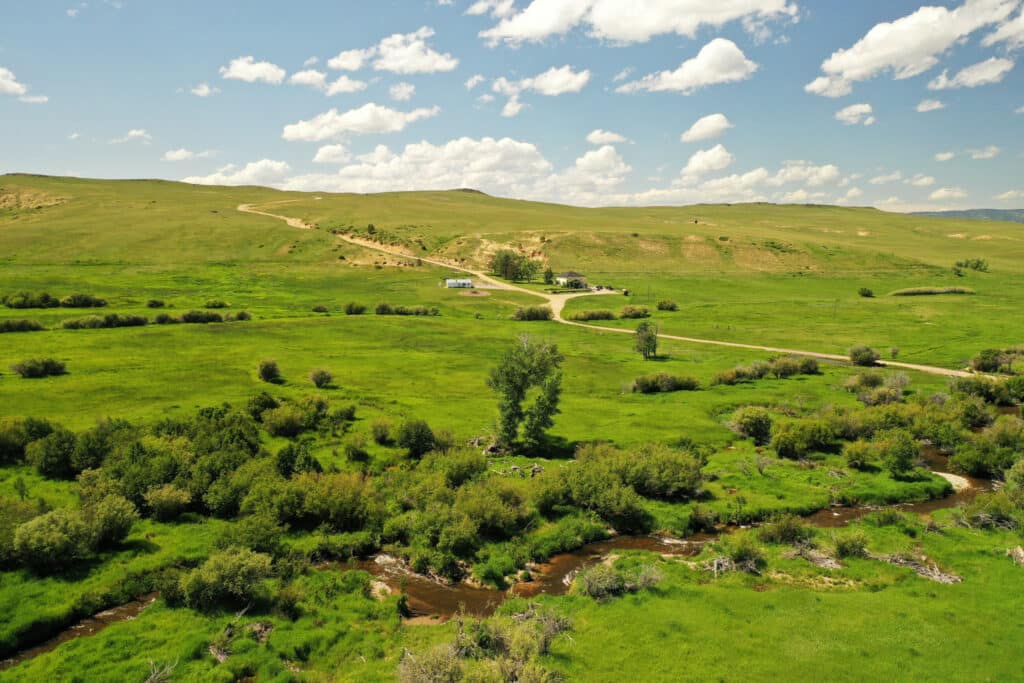 |
WHITE HOUSE
Built in 1917 as the original house on the ranch, the White House sheltered the family and also served as the ranch kitchen. It sits on a beautiful stretch of Camas Creek with a canopy of mature cottonwood trees which provide shade in a classic farmhouse yard setting, complete with a historic barn as the backdrop. This home was the primary dwelling on the ranch for many decades until the 1950s and has been updated and modernized over the years.
The main level includes the kitchen, dining, and primary living spaces which are complemented with four bedrooms and two bathrooms to make a wonderfully comfortable home that also has a full basement.
 |
 |
According to the Department of Natural Resources and Conservation, the ranch has current filings on irrigation water rights sourced from Camas Creek, Beaver Creek, Mule Creek, Moose Creek, and Elk Creek. The ranch also has current filings on numerous stock water rights. Priority dates for this water range from 1871 to the early 1900s. A full and complete list of water rights is available by contacting our Bozeman Office.
All water rights in Montana are subject to an ongoing adjudication process by the Montana Water Court and, as a result of that process, may be changed as to the validity, amount, priority date, place of use, and other such changes as the Court determines. The seller has made all the filings currently required and will transfer the water rights as they currently stand with no warranty of future viability.
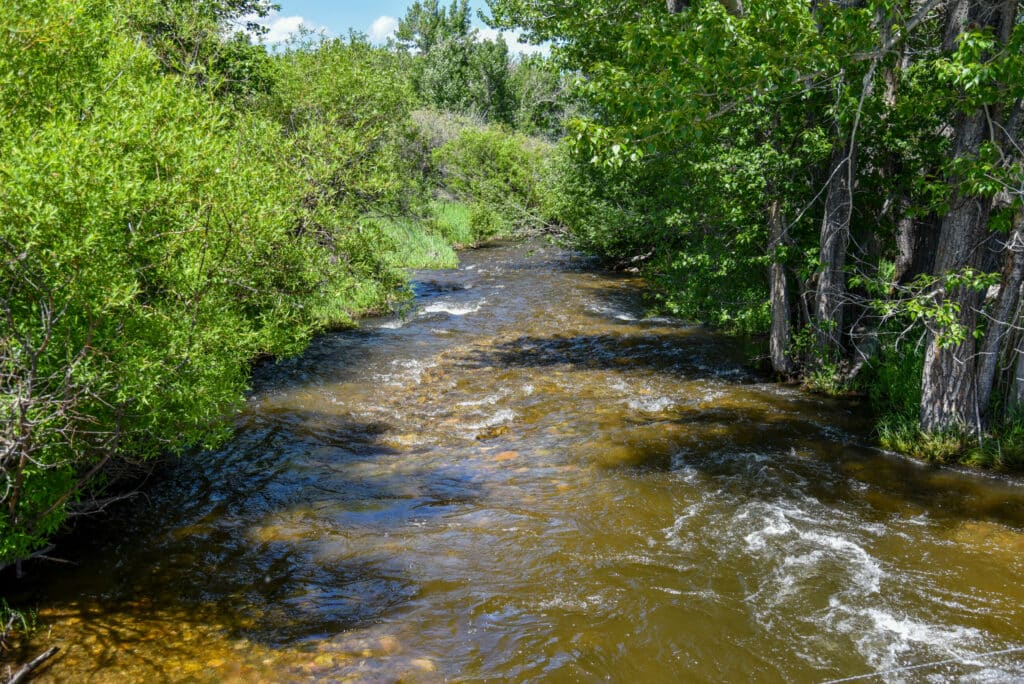
Northwestern Energy provides power via overhead lines that enter the property along State Highway 360. Triangle Communications provides landline telephone and fiber-optic internet, which has proven to be an excellent service and has reliable bandwidth. Additional internet and television options are available via satellite, should the next owner want to investigate those options.
Cellular coverage provided by Verizon is limited throughout the ranch, but high-speed and reliable internet access is available at the ranch homes, the headquarters, and the corrals.
The propane tanks are leased and filled regularly by either Berg Garage or Mountainview Co-op. The ranch diesel and gas tanks are filled by Berg Garage.
Household garbage and ranch waste are disposed of in a dumpster located at Headquarters and emptied weekly by Republic Services. Used oil is picked up on an as-needed basis by Oily Waste.
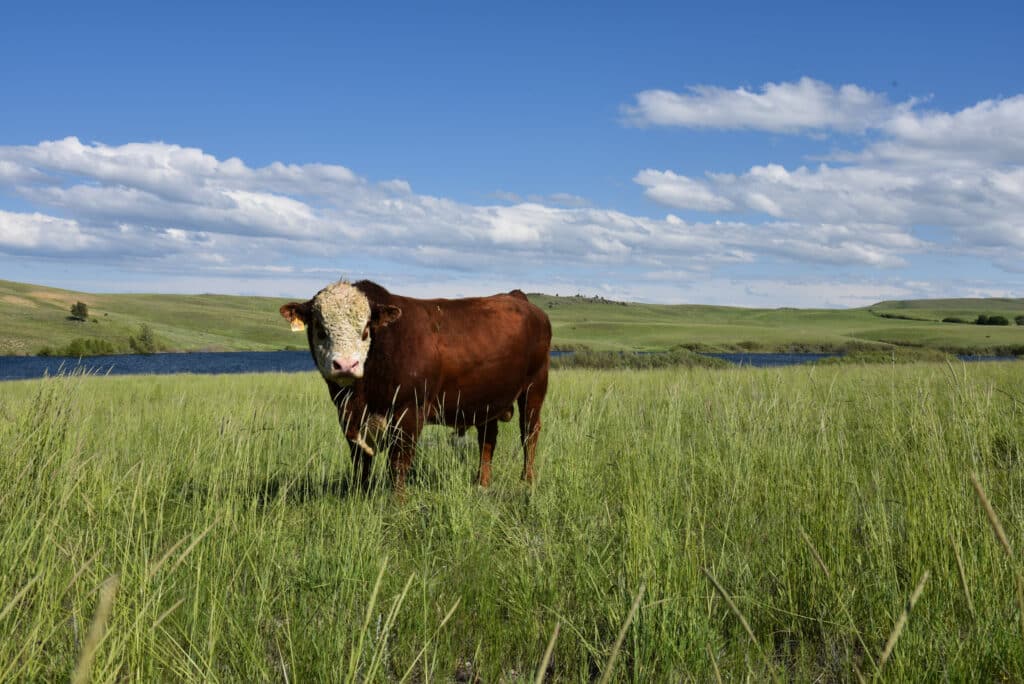
The taxes on real estate and improvements for 2022 were approximately $36,550.

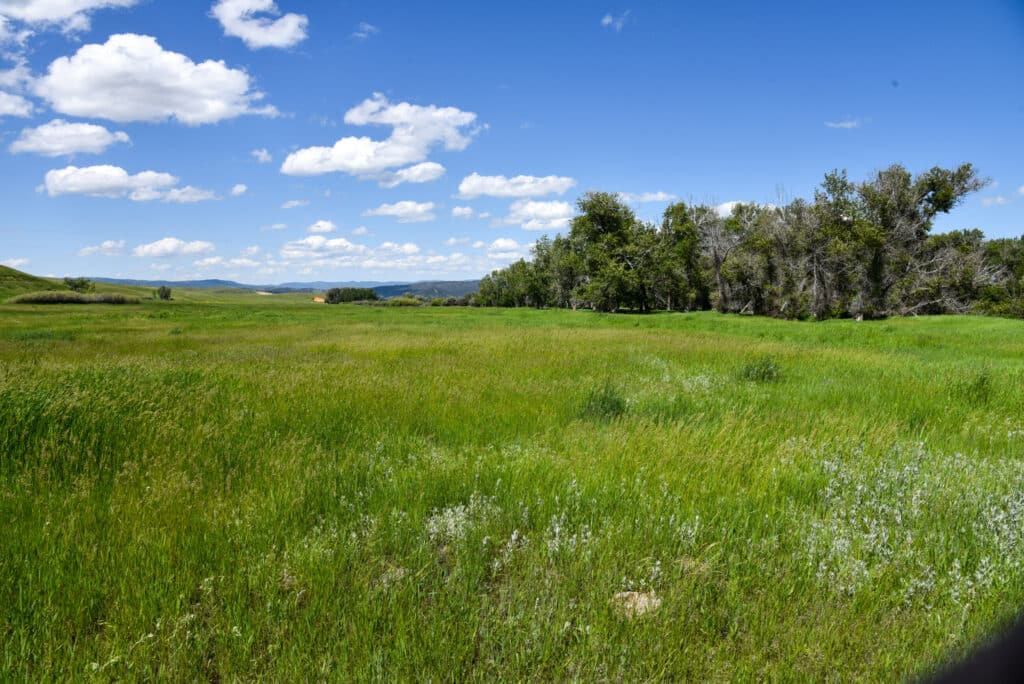
The seller will convey with the ranch 100% of whatever mineral, oil, gas, geo-thermal, hydrocarbon, solar, wind, and gravel rights it owns, subject to reservations by previous owners. The seller makes no representation as to the quantity or quality of any mineral or other subsurface rights appurtenant to the ranch.
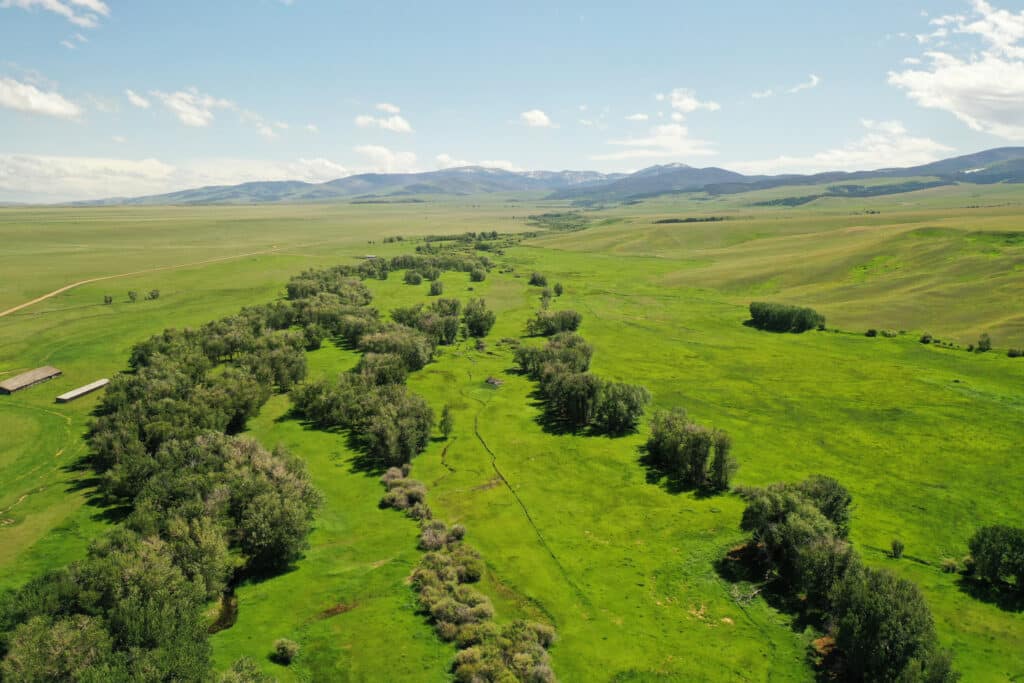
A conservation easement held by The Montana Land Reliance encumbers 4,272± acres along the Camas Creek riparian corridor, which represents about 50% of the Headquarters Unit. The intent of the Seller when placing this easement on this portion of the ranch was to effectively prevent any commercial development and maintain the pristine nature of this unsullied ecosystem. The easement does allow for three additional residences and associated outbuildings located within no more than two ten-acre building envelopes. Contact our Bozeman Office to obtain a copy of this document.

The seller hereby makes known that there may be variations between the deeded property lines and the location of the existing fence boundary lines on Camas Creek Cattle & Sheep Company. The seller makes no warranties regarding the location of the fence lines in relationship to the deeded property lines, nor does the seller make any warranties or representations regarding specific acreage within the fenced property lines.
The seller is selling Camas Creek Cattle & Sheep Company property in its “as is-where is” condition which includes the location of the fences as they now exist. Boundaries shown on any accompanying maps are approximate. The maps are not to scale and are for visual aid only. The accuracy of the maps and information portrayed thereon is not guaranteed nor warranted.

In the pre-European settlement era, the location known today as White Sulphur Springs was well-used by Native American Indians and referred to as the Valley of Peace. Crow Chief Plenty Coups recalled pilgrimages by warriors to the medicinal mud baths. The area was sought after as a place of peace, rest, and healing. The nearby Smith River was said to be used as a passage route or travel corridor by early settlers.
The name went from Trinity Springs to Brewers Springs. James Scott Brewer laid claim to the thermal springs while passing through the Carroll Trail in stagecoaches when he realized it was a perfect place to rest, calling the name of the stop Brewers Springs. When Major R.C. Walkers purchased half of the interest, the location became a business endeavor. After the pool was developed, a bathhouse, cabins, and a stable followed. The destination was frequented by adventurous travelers and the men stationed at Camp Baker, a U.S. Army outpost. Later the name changed to White Sulphur Springs to describe the white deposits that are left by the hot water that bubbles in the area.
The beautiful location of White Sulphur Springs, nestled in between the Little Belt Mountains, Big Belt Mountains, and the Castle Mountains was a vibrant place for agriculture, ranching, farming, and mining. Prospectors found the surrounding mountains rich in lead, copper, silver, gold, and other valuable minerals. It was not long until the area became a central trading spot. As mining took center stage, the financial progressions resulted in the county seat moving from Diamond City to White Sulphur Springs by a general election.
In 1892, local merchant Richard Sherman built an imposing stone home that was locally known as ‘The Castle’ and after many years of neglect has now been fully restored and has become the Meagher County Museum. Sherman also constructed a hydro-power electric light plant that made White Sulphur Springs one of the first towns in Montana to have electricity, if only for about six hours a day.
The city of White Sulphur Springs remains as a focal point of the county continuing with its entrepreneurial and agricultural roots to this day.
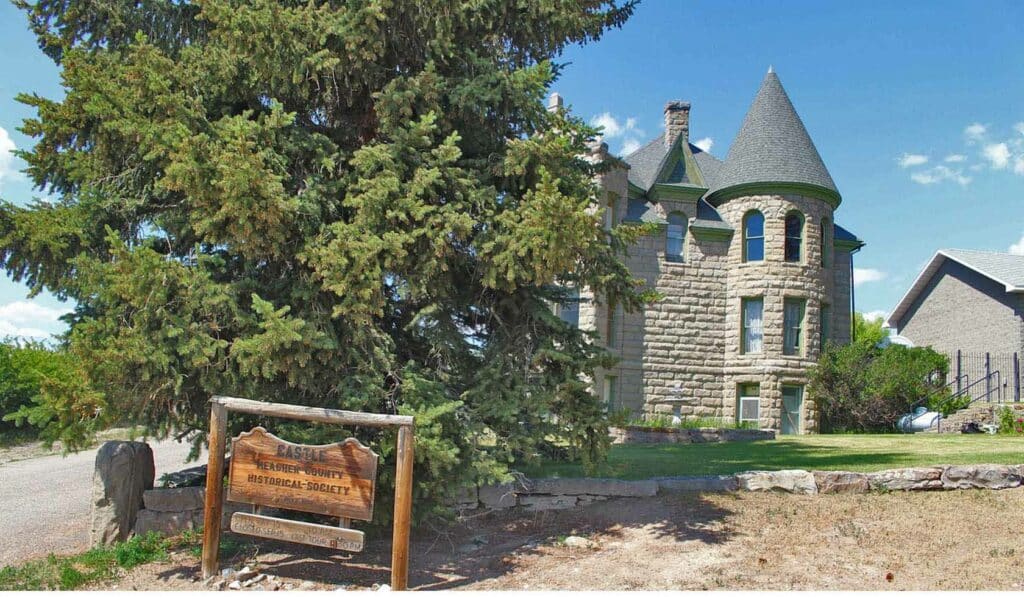 |
 |
Moses Doggett was born in Kentucky in 1829. He farmed in Kentucky and Indiana and in the late 1850s, began to farm in Iowa. He traveled to Pikes Peak in Colorado in 1861 to look for gold. He returned to Iowa as the Civil War raged in 1862. Moses (a southerner) and his wife Susan Rose made the decision to take their young family west to the gold fields of Montana. They arrived in Virginia City, Montana on August 30th of 1863. Two months later, Susan Rose gave birth to Jefferson Davis Doggett, the first white male child born in what is now the state of Montana.
Moses looked for gold in Alder Gulch near Virginia City and a year later, the Doggetts moved again to seek gold in Last Chance Gulch in what is now the city of Helena. The next year, Moses and Susan Rose moved up the Missouri River to the west side of the Big Belt Mountains near present-day Townsend and began to produce food for the many mining camps in the vicinity.
Jefferson Doggett, following several years of running a pack string of mules hauling supplies to miners, began to raise sheep in the area. He assembled various parcels of land on both sides of the Big Belts and by the early 1900s had a sizable number of sheep. In 1914, when the First World War broke out, the demand for wool and mutton soared. Jefferson looked to expand his operation and purchased a ranch directly east of the family operation on the east side of the Big Belt Mountains along Camas Creek and continued to run sheep on both sides of the mountain. Following his graduation from the University of Montana, Howard Doggett, Jefferson’s only child, began to operate the family ranches.
Unfortunately, the pendulum swung in the other direction in a few short years. In 1929 with the crash of Wall Street, the economy came to a sudden halt. The onset of the Great Depression saw commodities and land values plummet and the Doggetts soon found the ranch along Camas Creek to be worth pennies on the dollar. Needing money to operate the ranch, Howard sat with his banker anticipating handing over the deed to the ranch. To his surprise, the lender not only provided him with the needed operating capital but encouraged him to remain diligent, until the economy would once again rebound.
In 1948, the Camas Creek Cattle & Sheep Company was organized. Howard’s twin sons, Jeff and Bill Doggett graduated from the University of Montana in 1952 and moved back to the ranch to run it jointly. At the time, the ranch was running primarily sheep—as many as seven to eight bands. The brothers switched from raising sheep to raising cattle in the mid-1960s.

As the two brothers’ families grew, Bill moved his family to a ranch near Virginia City in Alder Gulch—the same place that first attracted his great-grandparents, Moses and Susan Rose Doggett in 1863. Jeff and his family stayed and operated the Camas Creek Cattle & Sheep Company and eventually turned the management over to his son, Jock and his wife Jamie.
For 160 years, the Doggett family has lived and prospered in the Big Belt Mountains. Five generations have raised sheep and wool, cattle, mules, horses, crops, and kids. The Doggett Family history is steeped in a strong work ethic and a commitment to producing food for a hungry world while protecting and enhancing the land. This multi-generational effort shows in this beautiful place.
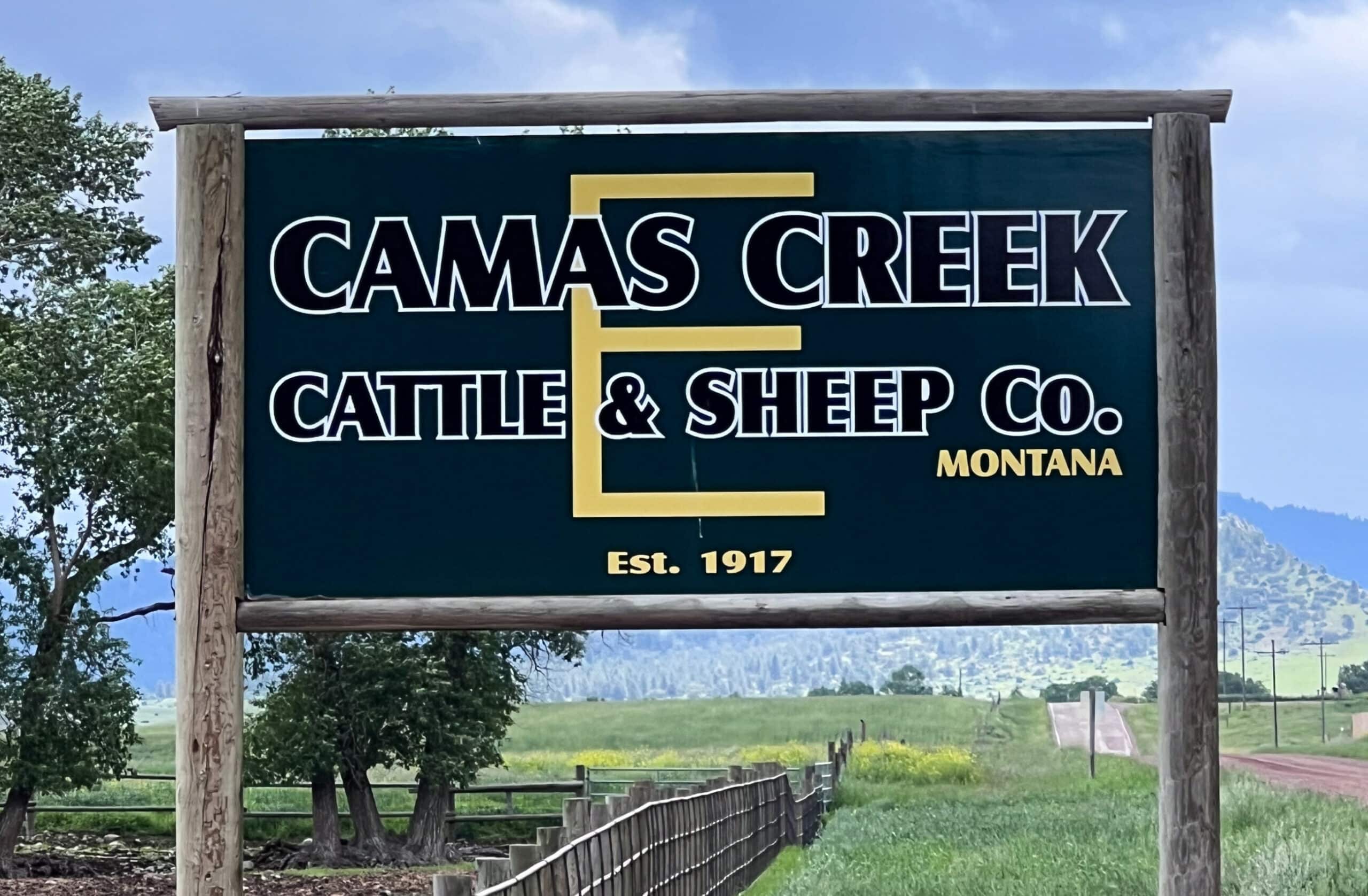 |
 |
Recreational options are abundant around White Sulphur Springs. Located in the heart of the Lewis and Clark National Forest, the area is characterized by flat glaciated plains, expansive river valleys, and mountain peaks brimming with forests. Whether you want to be active or take it easy, access to many forms of recreational opportunities is unlimited.
Downhill skiing at Showdown Ski Area, Montana’s oldest ski area, is a half-hour away in the Little Belt Mountains. Known for its all-natural snow and few crowds, the vertical drop is 1,400′ and the runs offer skiing for many abilities. The lodge offers ski and snowboard equipment rental, dining, a coffee bar, and a lounge. The area also has excellent snowmobile and cross-country ski trails.
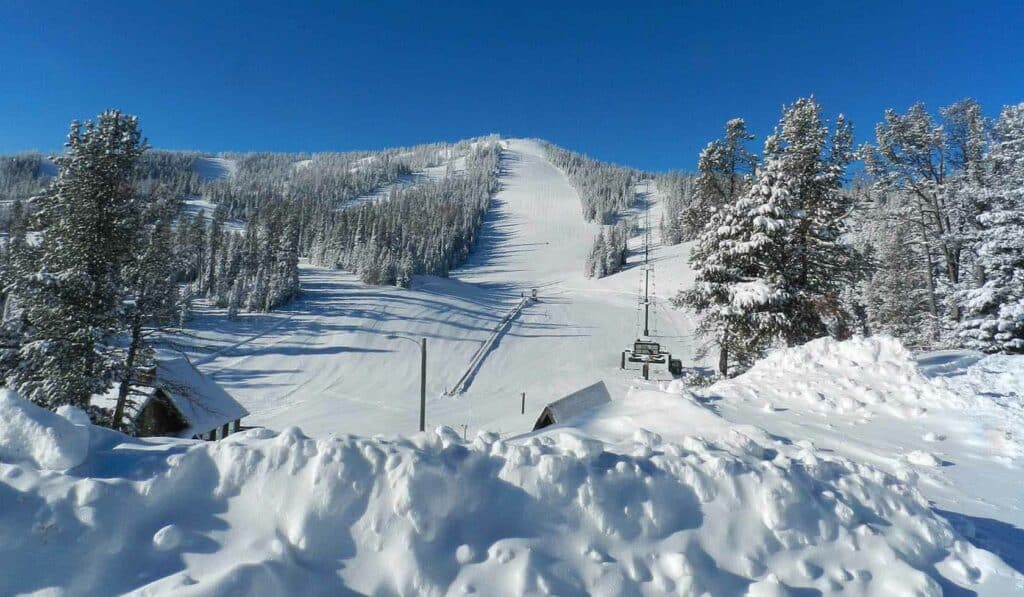
The Smith River, which originates in the Castle Mountains, flows southwest past White Sulphur Springs and ends as a tributary of the Missouri River. Known for its spectacular float trips and fishing, the Smith River State Park is only accessible via a permit due to its popularity. The float begins at nearby Camp Baker and continues for 59 miles through canyons and beautiful scenery to the takeout at Camp Eden, near Ulm on the Missouri River.

Newlan Creek Reservoir is located just down the road from the ranch providing a larger reservoir recreational experience. The 265-acre reservoir attracts anglers with rainbow and brook trout while boating enthusiasts utilize the reservoir for waterskiing and sailing.
White Sulphur Hot Springs is conveniently located on Main Street in the heart of White Sulphur Springs. It boasts three hot springs as well as a motel for guests traveling from out of town. The facility is open daily year-round and offers a 30’ x 35’ outdoor pool, a 10’ x 15’ indoor hot pool as well as a new outdoor pool that maintains a temperature of approximately 103 degrees.
The surrounding area has many hiking and biking trails for various abilities as well as campgrounds. A US Forest Service office is situated in White Sulphur Springs and is equipped with maps of locations and current information.
The town offers a wide range of outdoor concerts, seasonal festivals, and sports competitions to pass the time. One festival that has grown in recent years is the annual Red Ants Pants Musical Festival which usually occurs at the end of July and takes place in a pasture just outside of the city limits. Vendors and musicians come from far and near to perform and sell their goods. The non-profit foundation is dedicated to women’s leadership, working family farms and ranches, and rural communities. Revenues are used to fund community grants and other local programs.
Recreational opportunities on the ranch itself are numerous including hunting, fishing, horseback riding, and enjoyment of all the wildlife that passes through the ranch. Wildlife is naturally drawn to the area and the lush corridor created by Camas Creek. Bears, elk, mule deer, antelope, coyotes, and foxes can often be seen. The reservoir and ranch topography attract several species of birds including mountain bluebirds, hawks, ducks, geese, sandhill cranes, and osprey.
The hunting on the ranch itself is of extremely high quality and has historically been leased to Avalanche Basin Outfitters based in White Sulphur Springs. Their hunting lease is in place for the 2023 hunting season after which there are no further commitments. This arrangement could be extended or adjusted depending on the plans of the next owner.
The outfitter typically brings in about 25 hunters annually, and according to the seller, the outfitter has been excellent to work with and has done a good job managing the elk and deer herds in the area. The outfitter hunts both archery and rifle and is incredibly careful not to stress the herds. Elk herds ranging in size from 150 to 200 traverse the Clear Range Unit which is a safe haven for them and far away from any public pressure.
An appealing, but modest hunting camp is located just off the former county road along Beaver Creek on the Clear Range Unit. The existing well-maintained manufactured home, which serves as the hunting camp headquarters, is owned by the seller. The small cabins located at the compound are on skids and are owned by the outfitter and do not transfer with the sale of the ranch. The well provides domestic water to the hunting camp and also feeds a large cistern that supplies water to four stock tanks in the eastern pastures.
The ranch is in hunting District 446 (East Big Belt) which offers general tags for deer and elk. Additional information and hunting regulations can be found on the Montana Fish & Game website www.fwp.mt.gov.
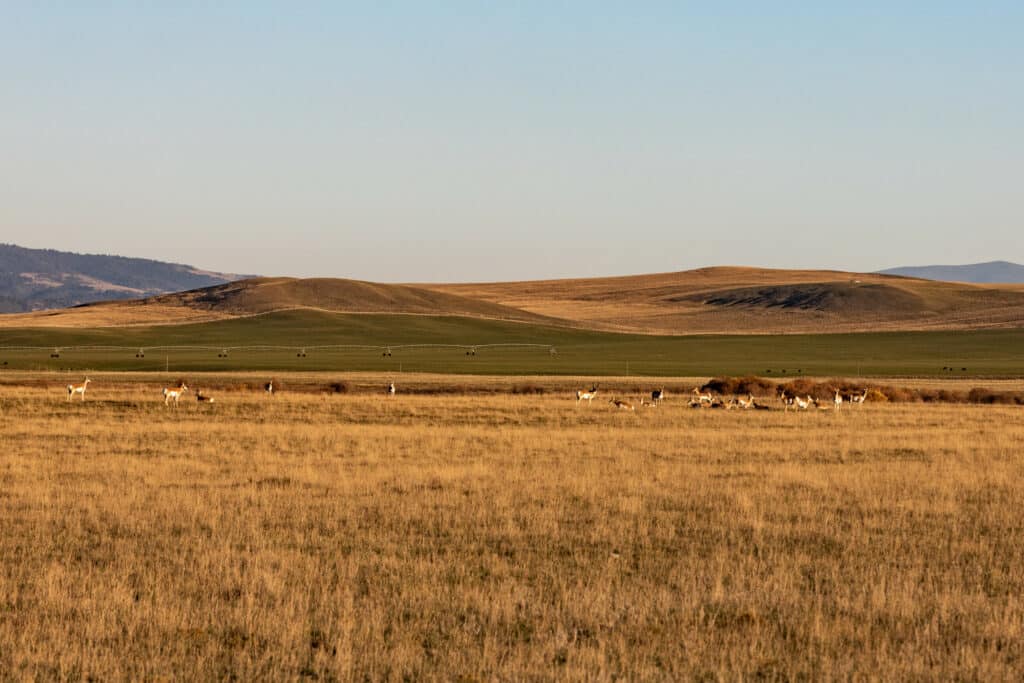
The ranch operates with three full-time employees along with several seasonal employees that help in the summer with irrigation and haying. The seller has created a positive healthy work atmosphere which is reflected by the longevity of their staff. The seller and the employees have indicated their openness to assist a new owner in the transition of the ranch and its continued operation.
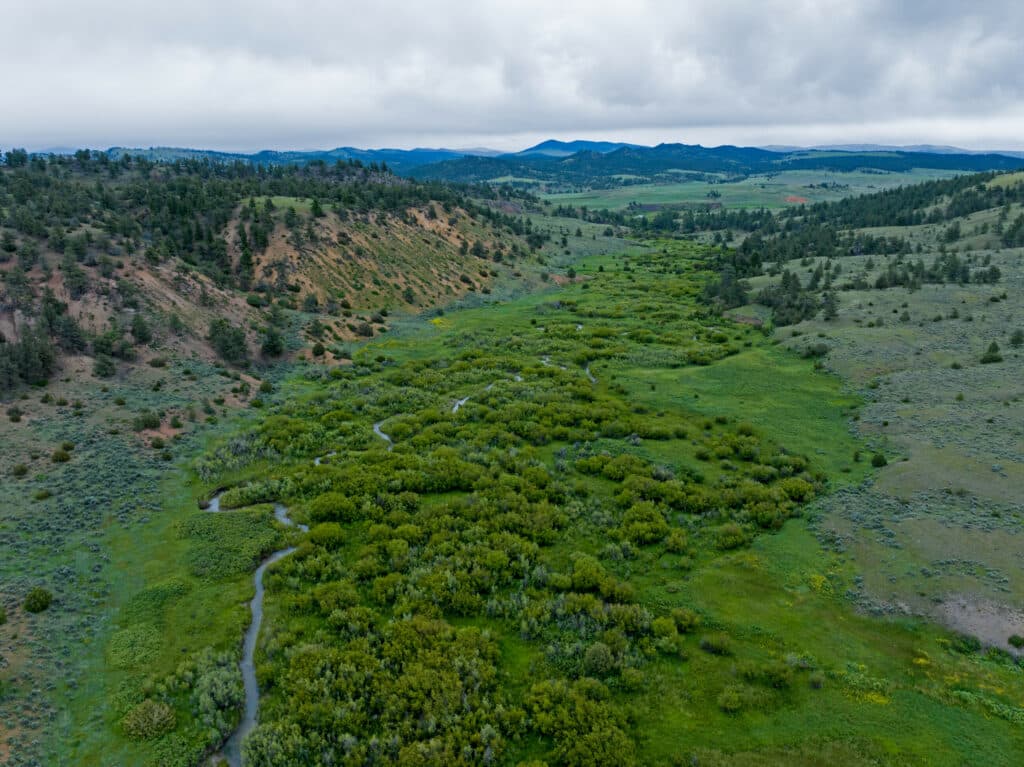
Camas Creek Cattle & Sheep Company provides the unique opportunity to acquire a recreational and working ranch encompassing approximately 36,621± total acres in the heart of some of Montana’s best cattle and recreational country. The size, scope, and condition of this ranch provide all the necessary ingredients for a successful investment property along with unlimited recreational opportunities. For those who have tracked the large ranch/recreational market in Montana for the past several years, this offering is very competitive in today’s market with desirable amenities in close proximity to the vibrant Montana cities of Bozeman, Livingston, and Helena.
The current owners have done an excellent job of managing the ranch—conservative grazing patterns and enhancement of deer, elk, and upland game bird populations. Pride of ownership is evident throughout.
The plentiful water resources combined with abundant big game, upland birds, and private fishing make this an extremely desirable holding and a rarity in today’s market.
In many similar offerings, considerable amounts of money have been spent on ill-designed and often times gargantuan homes and ancillary buildings which the buyer must uncomfortably assume and, to one extent or another, pay for. The homes and working improvements on Camas Creek are well done and appropriate. The proud new owner will be free to thoughtfully place a personal residence on this wonderful ranch that will attract family and friends for many decades rather than grudgingly tolerating “overbuilt improvements” that don’t meet their needs.
Finally, this attractive holding has bona fide potential for placement of an additional conservation easement and enjoying the personal satisfaction of environmental preservation plus the tax advantages attendant with such a decision. Every one of the viable conservation organizations will be pleased and extremely helpful in structuring an easement on the remainder of the ranch.
With no logical successors to take over the ranch, it is the goal of the seller to transition the ranch operation to a buyer who will continue the legacy while enjoying and appreciating the ranch as much as they have over the multiple decades of ownership. They also hope the buyer will embrace the culture, history, and special community in this part of Montana. One goal of the ranch operators is to establish a foundation for a portion of their sale proceeds to give back to the local community which has been so good to them during the term of their family’s ownership.
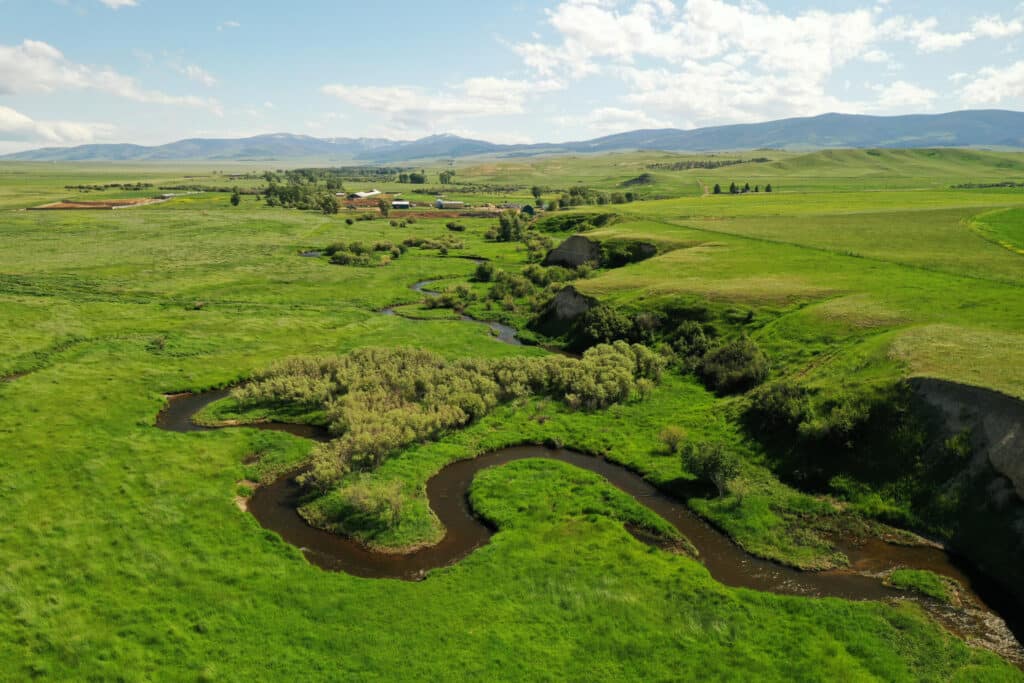
OFFERING PRICE & CONDITIONS OF SALE
Camas Creek Cattle & Sheep Company, as described herein, is now offered at US $58,750,000.00 Cash or at Terms acceptable solely at the discretion of the Seller.
The conditions of sale are as follows:
- All offers to purchase, or letters of intent must be in writing and accompanied by earnest money made payable to the escrow account of Flying S Title Company in Great Falls, Montana;
- Earnest money deposits will be placed in escrow with Flying S Title Company, which will then place the funds with local banks at nominal rates of interest accruing to the benefit of the Buyer until Closing, should the appropriate paperwork be completed;
- All Prospective Buyers must demonstrate to the satisfaction of the Listing Agents the financial capability to purchase the ranch prior to scheduling a personal tour of the ranch;
- The Seller will provide and pay for a standard owner’s title insurance policy. Title to the real property will be conveyed by a limited warranty deed;
- All of the appurtenant water rights controlled by the ranch will be transferred to the Buyer at Closing, and all of the mineral rights which the Seller actually own will be conveyed to the Buyer at Closing;
- Buyers’ Brokers are welcome and invited to contact Mike Swan or Tim Anderson with Swan Land Company for additional information and to set up a private ranch tour;
- Any additional documentation provided to Prospective Buyers and their Agents related to and expanding upon the information contained in this offering brochure may be subject to terms of a Confidentiality Agreement to be signed by the Prospective Buyer and their Agents prior to the delivery of such documentation.
The Seller reserves the right to affect a tax-deferred exchange for other real property in accordance with provisions in Section 1031 of the Internal Revenue Code. The Buyer will not be required to incur any additional expenses nor to step into the chain of title on any property which the Seller may acquire.
This entire Offering is subject to errors, omissions, prior sale, change, or withdrawal without notice and approval of purchase by the Sellers. Information regarding land classifications, acreages, carrying capacities, crop yields, potential profits, hunting districts and regulations, etc., are intended only as general guidelines and have been obtained from sources deemed reliable; however, accuracy is not warranted or guaranteed by the Sellers or Swan Land Company. Prospective Buyers should verify all information to their sole and complete satisfaction.
TERMS OF INSPECTION
A 48-hour notice is requested to make proper arrangements for an inspection of Camas Creek Cattle & Sheep Company.
Swan Land Company has been authorized by the Seller to act as their Exclusive Real Estate Broker on the sale of Camas Creek Cattle & Sheep Company. Since 2002, we have focused on the brokerage of significant ranches, farms, and recreational properties throughout the Rocky Mountain West.
This Offering is based on information believed to be correct; however, it is subject to errors, omissions, prior sale, and change or withdrawal without notice. Information contained herein has been provided by the Sellers or obtained from other sources deemed reliable. The Agent does not, however, guarantee accuracy and recommends that any Prospective Buyer conduct an independent investigation.






































Please submit your email to receive access to media downloads.
Michael S. Swan

Timothy Anderson

Suggested Properties


Camas Creek Cattle & Sheep Company
- 36,621 Total
- $58,750,000


Crazy P Ranch
- 1,749 Total
- $18,500,000






